mudd




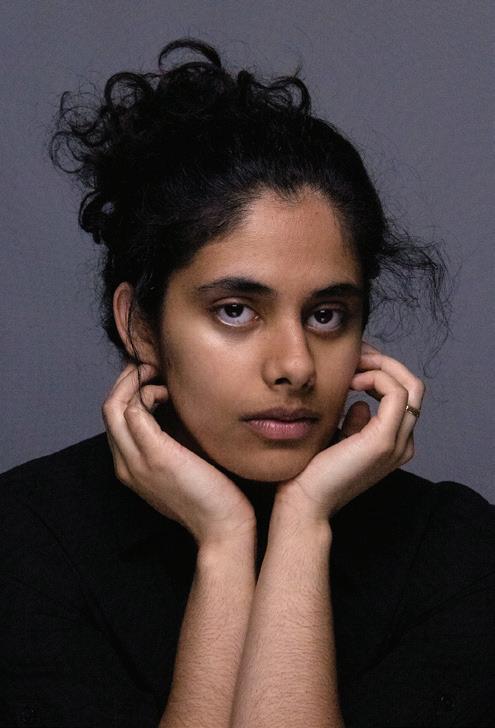
 Students in art professor Ken Fandell’s Portraits course explore elements of portrait photography from the study of techniques and history to contemporary processes and issues. Traditional concerns such as framing, composition, lighting and camera controls inform contemporary issues such as retouching, surveillance, facial recognition and AI.
Vani Sachdev ’24 photographed by Kelly Yang ’24
Photo by Megan Chen ’24
Jayati Anshu SCR ’24 photographed by Arya Mididaddi ’24
Students in art professor Ken Fandell’s Portraits course explore elements of portrait photography from the study of techniques and history to contemporary processes and issues. Traditional concerns such as framing, composition, lighting and camera controls inform contemporary issues such as retouching, surveillance, facial recognition and AI.
Vani Sachdev ’24 photographed by Kelly Yang ’24
Photo by Megan Chen ’24
Jayati Anshu SCR ’24 photographed by Arya Mididaddi ’24
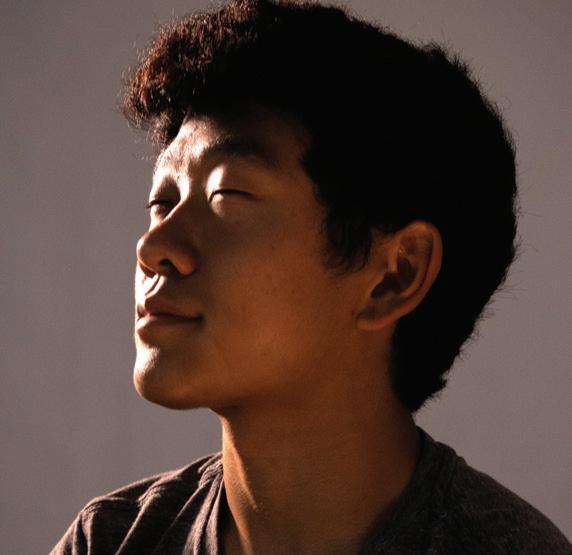

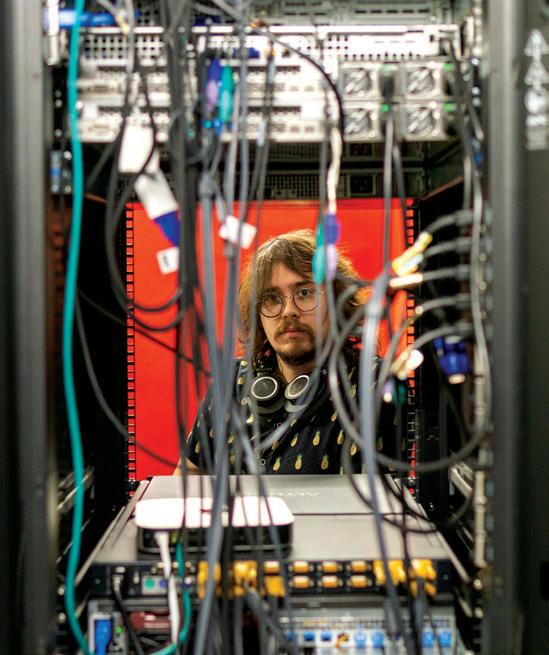
 HMC staff engineer Xavier Walter photographed by Jordan Stone ’24
Nilay Pangrekar ’24 photographed by Arya Mididaddi ’24
Computer Science Department program assistant Chelsey Calingo photographed by Megan Chen ’24
Mark Ying ’25 photographed by Anna Rogers ’25
HMC staff engineer Xavier Walter photographed by Jordan Stone ’24
Nilay Pangrekar ’24 photographed by Arya Mididaddi ’24
Computer Science Department program assistant Chelsey Calingo photographed by Megan Chen ’24
Mark Ying ’25 photographed by Anna Rogers ’25

Khadija Noor, an exchange student from Pakistan, spent a memorable summer challenging herself, making new friends and exploring U.S. culture
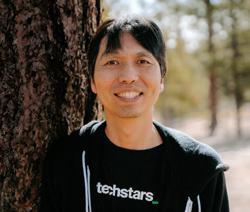
18
Entrepreneur Nicholas Seet ’99 has drawn on a wide range of resources both human and natural in his quest to transform deserts into forests

Having had excellent mentors throughout her academic career, Jessica Wu pays it forward
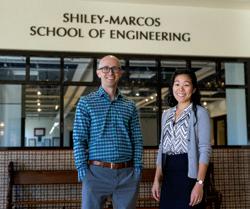
Follow Harvey Mudd College Instagram, Threads – @harvey_mudd Facebook – @harveymuddcollege LinkedIn – harvey-mudd-college X/Twitter – @harveymudd
Read Mudd Magazine
Website: magazine.hmc.edu
Go paperless: If you wish to stop receiving the printed magazine, write to us at communications@hmc.edu. We’ll send you an email when new editions are posted.
Fall/Winter 2023 | Volume 24, No. 1
Mudd Magazine is produced three times per year by the Office of Communications and Marketing.
Acting Chief Communications Officer, Senior Editor
Stephanie L. Graham, APR
Art Director
Robert Vidaure
Senior Graphic Designer
Joshua Buller
Associate Directors
Sarah Barnes, Muneeza Tahir
Writers
Judy Augsburger, Dominic Indolino, Arturo Molina
Contributing Writers
Melanie A. Farmer, Kristin Baird Rattini, Elaine Regus
Contributing Photographers
Zachary Barron, Samantha D'Anna, Jeanine Hill, Sidney Tchanyoum ’25
Vice President for Advancement
Hieu T. Nguyen
Chief Communications Officer
Timothy L. Hussey, APR
Mudd Magazine
(SSN 0276-0797) is published by Harvey Mudd College, Office of Communications and Marketing, 301 Platt Boulevard Claremont, CA 91711.
Nonprofit Organization Postage Paid at Claremont, CA 91711
Postmaster: Send address changes to Harvey Mudd College, Advancement Services, 301 Platt Boulevard, Claremont, CA 91711.
Copyright © 2024—Harvey Mudd College. All rights reserved. Opinions expressed in the Mudd Magazine are those of the individual authors and subjects and do not necessarily reflect the views of the College administration, faculty or students. No portion of this magazine may be reproduced without the express written consent of the editor.
Mudd Magazine staff welcomes your input: communications@hmc.edu or Mudd Magazine, Harvey Mudd College, 301 Platt Boulevard, Claremont, CA 91711
magazine.hmc.edu

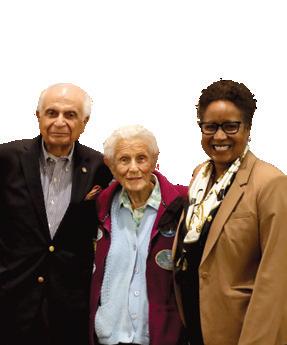
Iris Critchell, instructor of aeronautics emerita, has made an outsized impact on the alumni, the College and beyond. I was so pleased to have her on campus in November to greet author and retired Northrop Grumman executive Michael Ciminera (left). He presented her with his two-volume book The Aircraft Designers, A Northrop Grumman Historical Perspective. While doing research, he used the Bates Aeronautical Library, met with Critchell and benefited from her wealth of knowledge to help capture the history of the organization where he worked for 50 years.
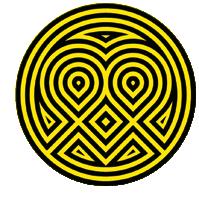
Ubumuntu
I spent International Education Week (mid-November) at Carnegie Mellon University Africa, hosted by Interim Director Conrad Tucker and his team and could not have asked for a more moving and impactful experience. Their work across AI, robotics and energy systems is inspired by expanding opportunity through technology across Africa and the globe. I look forward to future partnership opportunities between our respective institutions. (The Ubumuntu symbol means “humanity.”)
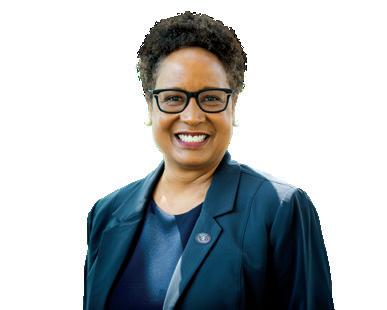
throughout my career in higher education, I have never met so many amazing, brilliant, kind people as I have at Harvey Mudd. To be in conversation, to break bread, have coffee—I really cherish it all.
Getting to know the community during this first semester is an important step before we transition into building out the strategic plan then move on to the comprehensive campaign. And really, all these things continue to happen in parallel, in some sense. After my first 100 days, I shared the Community Connections which summarizes comments into six thematic areas: culture and people, the student experience, academic programs, impact on society, places and spaces, and building capacity to invest in our future.
I’m incredibly delighted and heartened to envision Harvey Mudd as a beacon for all people who love STEM and more. That certainly comes through in the conversations that I’ve had. This is a community that is invested in not just innovation, but innovation with this very student-oriented mission. It’s where we want to have students who are good at STEM and good at life. I’ve heard elements of this repeatedly across stakeholders.
Having had those meetings, it helps me to think about what some of our next steps around strategic planning should be for Harvey Mudd. It’s important that our strategic plan really reflect us. That it allows us to really understand our commitments, our challenges and our opportunities for distinction.
“ It will be enriching to hear diverse perspectives and experiences, and your engagement in this process is critical. ”
–HARRIET B. NEMBHARD
Where is Harvey Mudd now? Where do we want to be? How will we get there?
I want these questions to be part of conversations among as many of us possible. It will be enriching to hear diverse perspectives and experiences, and your engagement in this process is critical.
I hope our strategic plan becomes a North Star that describes what is next. We can really look ahead, use assets the College already has, as well as the experiences you bring, to shape what the future should be. During the spring semester, we will embark on a very comprehensive, engaged approach to determine what the strategic plan will be.
The working groups— Imagining Harvey Mudd, Academic Vision, Student Experience— will think about what’s unique about Harvey Mudd and help chart a course that is particular to us. In January, community members will be asked to come to some level of consensus on: What are our values? What is the essence of Harvey Mudd? And what makes us distinctive? In February and March, working groups will draft reflections and responses.
A busy spring awaits us. Family Weekend is Feb. 2–3, Inauguration will be Feb. 29 and March 1, and Alumni Weekend is April 26–28— I hope to see you on campus. I also invite you to participate in strategic planning efforts. Watch your email and seize an opportunity to help us plan the future of Harvey Mudd College.
Harriet Nembhard President, Harvey Mudd College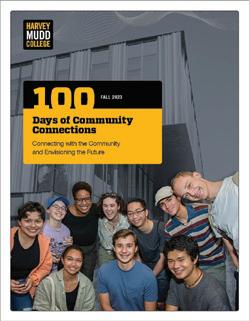

During her first 100 days, President Harriet Nembhard participated in more than 105 meetings and events with nearly 1,400 Harvey Mudd community members. In addition to feedback from these discussions, 187 people submitted thoughts online. This information was synthesized into six key themes that will help lead the College into the future. Community members are invited to share input on these themes as well as thoughts on Harvey Mudd’s core values, essence and distinctive qualities (bit.ly/Muddinput24).
View the report, 100 Days of Community Connections, on the Community Connections website.
hmc.edu/presidents-office/100-days

Initially taking on a two-year appointment (through June 30, 2024) to facilitate the presidential leadership transition, Tom Donnelly, vice president for academic affairs and R. Michael Shanahan Dean of the Faculty, will now serve in his current role through June 30, 2025.
THE INAUGURATION OF HARRIET B. NEMBHARD
THE SIXTH PRESIDENT OF HARVEY MUDD COLLEGE
THURSDAY, FEBRUARY 29
Harvey Mudd College
2:00–3:00 p.m. | Annenberg Leadership and Management Speaker Series with Ho Nam ’88, Managing Director, Altos Ventures
3:00–5:00 p.m. | Honoring Our Progress
A community reception and tours of selected campus areas
FRIDAY, MARCH 1
10:00 a.m. | Investiture
Pomona College, Mabel Shaw (Big) Bridges Music Auditorium
Doors open at 9:00 a.m.
Lunch and celebration immediately following on Harvey Mudd campus
7:00–11:00 p.m. | Dancing and Desserts with President Nembhard
hmc.edu/inauguration
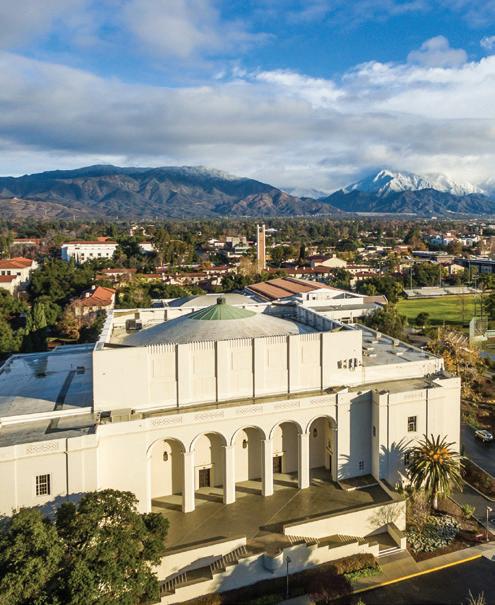
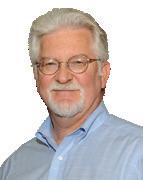
a highlight of the previous academic year was the successful search for and hiring of the College’s sixth president, and I’m grateful to all who contributed to this tremendous effort.
Community Connections events held in recent months have allowed alumni, parents, donors and friends, students, faculty and staff the opportunity to connect with our new president, Harriet Nembhard, since she began her tenure on July 1. For Nembhard, coming to Harvey Mudd College was a homecoming of sorts as she completed her undergraduate education at Claremont McKenna College, where she earned a bachelor’s degree in management-engineering and was a CMC alumna trustee for three years.
A nationally recognized leader in industrial and operations engineering, Nembhard spent her first 100 days at Harvey Mudd reaching out and connecting with hundreds of individuals, listening to their ideas and suggestions about how we can accelerate the College’s success in a rapidly changing world. Six themes emerged, and I look forward to building upon them to develop a strategic plan.
In May, the College community celebrated outgoing president Maria Klawe honoring her 17 years at the helm of HMC. During that time, Klawe worked tirelessly to promote the College nationally and internationally; she was recognized for increasing diversity and inclusion, and she led the College through its first major fundraising campaign in more than 25 years. Klawe is now president of Math for America, a nonprofit founded by mathematician and philanthropist Jim Simons to promote recruitment and retention of mathematics teachers in New York City secondary schools.
This past year, the College continued efforts to reestablish the Honor Code as a critical structure of campus culture. As many of you may know, the Honor Code states that Harvey Mudd students are expected to conduct
themselves with honesty and integrity both personally and academically and to respect the rights of others. A series of programs and events helped reacquaint students with the Honor Code and encouraged conversations about it. Efforts spearheaded by the Division of Student Affairs are continuing.
The Hixon Center for Climate and the Environment made great strides during 2022–2023 toward its mission of developing a leading undergraduate climate program that equips students with the knowledge and skills to tackle complex environmental issues. With the guidance of Hixon Center Director Lelia Hawkins, new classes, such as Climate Dynamics, and Games for Climate Literacy, are being offered along with a variety of seminars and electives that either focus on climate change or include it. In addition, two Core courses have been added, including a new biology Core course that has climate change as its central theme and STEM & Society: Climate Change, an interdisciplinary look at the climate challenge. The Hixon Center made progress recruiting faculty for joint appointments across all departments, adding Sarah Kavassalis, assistant professor of climate and chemistry (specializing in atmospheric chemistry, physical chemistry and scientific computing) and Lynn Kirabo, Maria M. Klawe Assistant Professor of Climate and Computer Science (equity in smart public transit systems).
As part of an ongoing initiative to maintain and modernize some of our aging buildings, the College continued preparing for installation of a backup generator that will safeguard important research and lab work in the academic complex (installation will occur in 2024). Projects involved replacing roofs, installing new HVAC systems and improving plumbing and power back-up.
In the online annual report, read more about the College’s fiscal and fundraising results for 2022–2023 as well as other academic year highlights, including:
• New faculty
• Class of 2027
• Continued excellent visibility and rankings performance
• Significant awards won by faculty and students
With President Nembhard continuing the tradition of strong and capable leadership and
with the support of a dedicated community, Harvey Mudd College will undoubtedly broaden its impact in STEM.
For more details about the past academic year, including financial and fundraising reports from the Business Affairs Office and the Office of Advancement, review the online annual report at hmc.edu/annual-report
Trustee emeritus
Michael Blasgen ’63
In Memoriam

Al Dorman, an emeritus trustee and close friend to HMC, died Nov. 14. He was an active board member from 1988 to 2005. As a civil engineer, he shaped the engineering field worldwide. He was chair and first CEO of AECOM, a global infrastructure company. As Disneyland’s civil engineer of record, Dorman signed the theme park’s original plans. The Dorman Family Foundation established HMC’s Dorman Student Altruism Prize, which recognizes a graduating senior, nominated and selected by fellow students, as “one who has done the most for his/her fellow students.”
climate experts, teacher-scholars and community partners were treated to a smorgasbord of ideas, innovations and insights designed to broaden participation in undergraduate climate education at the SENCER West Coast Regional Conference Sept. 14-15. The conference was sponsored by Harvey Mudd’s Hixon Center for Climate and the Environment and the Office of Community and Civic Engagement.
More than 130 registrants from colleges and universities across the nation attended the one-day conference either in person or remotely to hear presentations ranging from bridging disciplines in climate education to cross-disciplinary teaching. Organizers sought to increase the number of faculty involved in climate education and to bring together multiple perspectives to address the challenges of climate change.
“We felt that HMC both had something to offer and something to gain by connecting with local institutions and individuals interested in undergraduate education in climate,” says Lelia Hawkins, Hixon Center director and Hixon Professor of Climate Studies.
Two leaders in the field delivered keynote presentations. Veerabhadran “Ram” Ramanathan, who first discovered the climatealtering impacts of chlorofluorocarbons and other heat-trapping pollutant gases in the atmosphere, has been a driving force to enact policies to curb global warming. He is the founding chair of University of California’s Bending the Curve: Climate Education For All, a multidisciplinary undergraduate curriculum on climate change solutions taught at many campuses worldwide. He spoke about the need to educate the next generation if the world is to move from climate crisis to climate resilience.
Crystal Chisel, executive director of the Global Council for Science and the Environment, has worked with government, business and academic organizations to identify, analyze and implement a diverse portfolio of effective strategies for reversing climate change from local to global scales. She detailed her efforts to support collaborative, transdisciplinary, environmental and sustainability education and research in higher education.
Other speakers included Krista Hiser, senior lead and advisor for sustainability education and the Key Competencies Framework at Arizona State University and Mark Stemen, professor of environmental studies at California State University, Chico.
Conference co-organizers were Karl Haushalter, chair, HMC Department of Chemistry, and Seeley W. Mudd Professor of Chemistry and Biology, and Gabriela Gamiz, director of civic and community engagement.
“Climate justice and education calls us to work collectively,” Gamiz says. “This fits with our vision of civic and community engagement because working with our community is critical.”
The conference website is a rich resource for educators seeking to include climate education in their classrooms: bit.ly/SENCERhmc
72 in-person registrants
55 remote registrants
6 talks on bridging disciplines in climate education (crossdisciplinary teaching)
5 panelists on institutional-level reform in climate education
1 workshop on bringing climate into any course you teach
1 climate futures activity, a reflection on our place in the climate moment
The Dr. Bruce J. Nelson ’74 Distinguished Speaker Series is hosted by the Hixon Center and the Hixon Riggs Program for Responsive Science and Engineering

“You can think of AI as a collection of people working together in a new way, just like you can an economy. And so, if you do that ... you have clear ideas of how to integrate it into human life and into the human economy and have better philosophies for how it fits into human life.”
Jaron Lanier from his Sept. 19 talk “There is no AI.” He is a computer scientist, composer, artist, author and a pioneer in virtual reality (a term he coined). He is the “octopus” (Office of the Chief Technology Officer Prime Unifying Scientist) at Microsoft.

“If inequity is woven into the very fabric of our society … that can feel overwhelming. It’s everywhere, but that also means that each twist, coil and code is a chance for us to weave new patterns, practices and politics. The vastness of the problems that we are up against will be their undoing once we accept that we are pattern makers, that we don’t just have to accept the paradigms and patterns of old.”
Ruha Benjamin from her Oct. 19 talk “From Artificial Intelligence to Collective Wisdom.” She is the Alexander Stewart 1886 Professor of African American Studies at Princeton University, founding director of the Ida B. Wells Just Data Lab and an award-winning author.

hmc.edu/nelson
growing up in pakistan, khadija noor was always curious about education in the United States, particularly in STEM fields. Pakistan’s Sister2Sister Exchange Program, which provides exchange students a peek at the U.S. education system, works with host institutions like Harvey Mudd College to offer undergraduate courses related to the participants’ fields of study. Competition for the program is intense in Pakistan, with just 20 women selected every year.
Noor, a Generation Google Scholarship recipient who is pursuing a bachelor’s degree in software engineering from the University of the Punjab, was delighted when she qualified for the Sister2Sister program. Given that Harvey Mudd was her top choice because of the school’s reputation in STEM education, Noor was especially delighted when the College selected her to participate as an exchange student during summer 2023.
“A puzzle to unravel”
Ever curious to learn how mathematics can be used to solve real-world problems, Noor decided to sign up for a course on differential equations at Mudd, which focuses on such aspects. But Noor had not studied linear algebra like most of her classmates.
“The subject of differential equations was challenging for me because I’m not a math major, but Professor Darryl Yong often spent extra time after class and also in the evenings explaining concepts, which helped me a lot,” Noor says. “The level of excellence to which the College commits is marvelous. The instructors were the most amazing people I’d ever met.” Yong, in turn, describes Noor as “a very enthusiastic, energetic and gregarious person.”
“Dreams that dare to come alive”
In Pakistan, Noor teaches computer science to middle and high school students. She works part-time as a programming instructor and is delighted to apply techniques she learned from
Zachary Dodds’ Introduction to Computer Science class. Among her takeaways: a website where students can visualize code to help them understand how it is being executed.
In addition to pursuing a career in data engineering or data sciences, Noor aspires to be a role model for young girls in Pakistan. “Seeing the conditions of women in technology in my own country, I want to create a world in which every girl has access to educational resources,” Noor says. “Every girl should have an opportunity to prove her talent and be judged by her skills and abilities instead of her gender.” Noor’s time at Mudd has influenced this work, too: In collaboration with Dodds, Noor hopes to write a paper about computing education opportunities in Pakistan.
Back in Pakistan, Noor fondly remembers her summer exchange at Mudd. “My time spent there has doubtlessly been the best span of my life. I can never forget the amazing city of Claremont … a heaven of knowledge.”
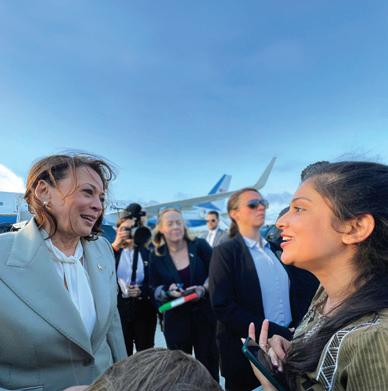
Noor says her time at HMC was memorable, especially the opportunity to meet Vice President Kamala Harris with other Harvey Mudd community members. Noor is shown right speaking with Harris.
Noor wrote this poem in Jon Jacobsen’s Differential Equations class. The assignment called for students to creatively summarize their class experience.
In the realm of knowledge’s vast domain,
A Pakistani girl embarked on a journey’s gain, From distant lands, she crossed the sea, To Harvey Mudd College, where she longed to be.
At Claremont’s campus, dreams took flight, A summer exchange program, shining bright, With eager steps and a curious mind, She ventured forth, leaving the past behind.
Differential Equations, the course she pursued, A challenge beckoning, she wholeheartedly delved into, In lecture halls adorned with wisdom’s grace, Professors Yong and Jacobsen, guiding her pace.
...
Read the full poem at magazine.hmc.edu
In an article published in Scientific American, Eliot Bush describes ways that evolutionary biology offers warnings—and tips—for surviving the advent of artificial intelligence. Arguing that machines’ ability to act independently and upgrade their own designs would be subject to the same evolutionary laws as bacteria, animals and plants, Bush makes a case that evolution has a lot to teach us about how AI might develop and how to ensure humans survive its rise.
A new approach (Heat–Cool) for measuring more accurate and reproducible specific heat capacities of materials is the subject of a paper by Professor Emeritus Jerry Van Hecke ’61, Brandon Wada ’20 and Oliver Baldwin ’21. The paper, published in Thermo, asserts that, in addition to better performance, the proposed method is faster and typically requires no additional calibration beyond the routine calibration of temperature and heat flow, with melting point standards common to all applications of differential scanning calorimetry.

David Vosburg gave an invited talk in a special 100-year celebration of the journal Organic Syntheses at the national meeting of the American Chemical Society in San Francisco. The symposium was “Scientific Advances in Organic Synthesis from Primarily Undergraduate Institutions.” Vosburg’s talk focused on research he conducted with Nate Luis ’23 and Kasey Chung ’25. The research was published in a special issue of the journal Organic Letters that features academic-industrial partnerships.
Vosburg also gave a talk on “Fostering a culture of green chemistry in the organic
laboratory” at the Green Chemistry and Engineering Conference last summer. He described his work in organic chemistry laboratory courses to emphasize sustainability, related to the Department of Chemistry’s signing of the Green Chemistry Commitment with Beyond Benign.
Alberto Soto, a postdoctoral fellow in the Program for Interdisciplinary Computing, has been accepted into the Society for Advancement of Chicanos/Hispanics & Native Americans in Science Postdoc Leadership Institute. The intensive two-day training develops leadership skills that help participants lead teams in a culturally responsive manner and provides a strong network of diverse STEM leaders. Soto is fascinated by animal behavior and locomotion. He uses computational tools and robotics to study the movement of animals during behaviors such as predator-prey encounters and fish schooling.
HMC makerspace Director Matt Spencer gave a Bite of Learning presentation designed for faculty who’ve used or want to use the makerspace in their classes. Spencer and makerspace manager Kim Neal, along with makerspace student stewards, are developing best practices for work in the makerspace.

The Institute for Operations Research and the Management Sciences (INFORMS) Forum for Women in ORMS named Susan Martonosi a recipient of the 2023 Award for the Advancement of Women in Operations Research and the Management Sciences at their annual meeting in October.
Mark Ilton is a recipient of Research Corporation for Science Advancement’s 2023 Cottrell Scholar Award. He’ll use the $100,000 grant to support two projects: one in his research field of the physics of soft matter and the other in physics
education. Ilton and his student researchers study the physics behind how some animals use elasticity to move quickly; specifically, the unloading dynamics of elastic materials and their connection to the ultra-fast movements of biological organisms, such as mantis shrimp and trap-jaw ants. For the educational component of the award, Ilton aims to improve access to undergraduate research opportunities, particularly for students from underrepresented groups in STEM.
Vatche Sahakian holds the Burton Bettingen Professorship of Physics, which honors a physicist whose commitment to undergraduate education marks that person as a leader in the field. He is interested in understanding the small-scale structure of space in a context where both gravitational dynamics and quantum mechanics become important.
An article by Daniel Tamayo was published by the American Physical Society. “Tackling the Puzzle of Our Solar System’s Stability” examines standard theories of planetary stability compared to a new theory, which explains why our planets avoid collisions for far longer than we once understood.
Humanities, Social Sciences, and the Arts
Isabel Balseiro is spending her sabbatical as a visiting professor at the Department of English Studies, Universidad Complutense de Madrid, one of Spain’s leading research institutions. She has been awarded a two-year research fellowship by the Ministry of Universities Government of Spain. Her research focuses on the life and work of Spanish poet María Acuña whose work Balseiro has curated and published in two collections. Balseiro seeks to write the first literary biography about her so that through the poet’s work and life, Balseiro can reconstruct a fuller picture of regional culture and the vanishing rural world of Extremadura, learn about the obstacles working-class women without formal education faced in a patriarchal society and gain insight into the survival strategies required in a Francoist regime, where anyone daring to step outside the prescribed order became an outcast.
The desire to uncover culturally fraught representations of difference, including gender, race and religion, is at the heart of the teaching and research of literature professor Ambereen Dadabhoy. In Anti-Racist Shakespeare and Shakespeare Through Islamic Worlds, Dadabhoy uses the work of William Shakespeare to explore these ideas.
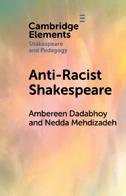
Cambridge University Press, January 2023
Co-authored with Nedda Mehdizadeh, continuing lecturer in writing programs at UCLA, Anti-Racist Shakespeare reveals that Shakespeare’s work is fertile ground with which to cultivate an anti-racist pedagogy. Dadabhoy says, “We tried to write it so that it could be accessible and useful to anyone who wants to approach anti-racist methods of teaching.”
Dadabhoy and Mehdizadeh explain how teaching Shakespeare through a race and anti-racism lens exposes students to the unequal structures of power and domination that are systemically reproduced within society, culture, academic disciplines and classrooms. “The book gives instructors and students ways to question and intervene in the system through the knowledge that we co-create in the classroom, which then empowers our students to think about these systems of power in their individual projects and other courses,” Dadabhoy says.
“We use many theoretical methods in the book, like postcolonial criticism and feminist criticism, but we also tried to be intersectional, so that when we’re thinking about race, we’re also thinking about gender, and we’re also thinking about class, and we’re also thinking about religion,” Dadabhoy says. “For us, there is a benefit for what this does in the classroom. I really see my job as using literature to teach my students how to be critical readers and thinkers of the world around them.”
Anti-racist Shakespeare is available as Open Access on Cambridge Core.
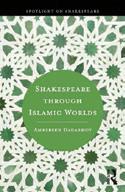
“Shakespeare Through Islamic Worlds is based on the fact that Shakespeare doesn’t write about Islam,” Dadabhoy says. “I decided to investigate why not.”
For Shakespeare’s contemporaries, the topic of Islam was a regular feature in
theatrical work. “Many of his contemporaries were writing about the Mediterranean and English and European contact with Muslim cultures like the Moroccan Saadian dynasty and the Ottoman Empire. Moors feature quite heavily in a lot of plays in the period.”
Moors also regularly appear in Shakespeare’s plays, but he doesn’t identify them as Muslim. “In The Merchant of Venice, the Prince of Morocco is never identified as a Muslim,” she says. “However, if he’s the Prince of Morocco, he can only be a Muslim. There’s no other option.”
So, if Shakespeare’s work clearly contains Islamic characters and influences, why wasn’t he more explicit about it?
“We don’t deal a lot with authorial intent,” Dadabhoy says, noting that Shakespeare remains a mysterious figure about whom not a lot is known. However, she says, “I think texts reveal the priorities and the ideologies of the culture that is producing them. [In Shakespeare’s time] there are so many anxieties and concerns about increased traffic and trade in the Mediterranean that’s going on and about increased contact with and enslavement of African people. These plays are part of a period where Europe is starting to position itself as white and as Christian, so Shakespeare’s works are participating in that kind of national identity construction in some way.”
One of the main questions that guided Dadabhoy’s research for the book was: Why does Shakespeare conjure Islam through metaphor? “If you look up the phrase ‘turning Turk,’ for example, or just even the word, ‘Turk,’ they appear several times as a trope or a metaphor, but the characters aren’t there,” she says. “So, what kind of ideological work is Islam doing for Shakespeare, where he needs the references to these characters for certain reasons, but more broadly the work disengages with the topic?”
Dadabhoy notes that Shakespeare removes Muslims or makes them peripheral or referential because he’s creating a Europe and a ‘globe’ that is free from Islam, racial otherness and religious otherness. By consigning the diverse cultures of the Islamic regimes that occupied and populated the early modern Mediterranean to the peripheries, Shakespeare constructs a Europe and Mediterranean freed from the presence of non-White, non-European and non-Christian others, which belied the reality of the world he occupied.
Dadabhoy hopes the book will encourage readers to think about the idea that “just because something isn’t there, doesn’t mean that we can’t look for the traces. It’s important to note that I’m not trying to make Islam relevant by having Shakespeare deal with it. I’m not trying to make Shakespeare a kind of savior to Islam. The book is very much a project where I’m trying to put Muslims back in the places from which they were evacuated by Shakespeare.”
members of the harvey mudd college community gathered in Sprague Plaza Nov. 10 to celebrate the life and legacy of Gary Evans, emeritus professor of economics, who died Sept. 20 after a long period of illness.
Darryl Wright, philosophy professor and Department of Humanities, Social Sciences, and the Arts chair, welcomed Evans’ family members, former students and colleagues, several of whom shared thoughts and stories. “We in the department loved Gary dearly and were uplifted every day that we were with him by the love and support he showed all of us and the example he set of a faculty member who was thoroughly dedicated to the ideals of the College and to our students,” Wright said.
Leslie Khale, Evans’ eldest daughter, said, “The In Memoriam page was simply amazing. They went through Dad's career and all his academic achievements, and there were things in there that I didn't even know. He was an amazing man, as we all know, and the heartfelt sentiments that his colleagues and students left on the page got my dad's personality down to a T.”
Josh Jones ’98, founder of HMC INQ, Harvey’s Angels and one of Evans’ former students, shared fond memories and lessons he took away from Evans’ economics class. “It was like getting taught by Indiana Jones. He was so encouraging and just gave everyone the courage to do what they wanted to do,” Jones said. “He was like a second father to me and a role model. One of my best friends, too.” Evans championed entrepreneurship at Harvey Mudd College. An expert in enterprise, financial institutions and small business development, he taught courses in macroeconomics, entrepreneurship and finance from 1981 to 2020. Evans was also a strong advocate for faculty governance and for years was the voice of the faculty on the Faculty Budget Committee.

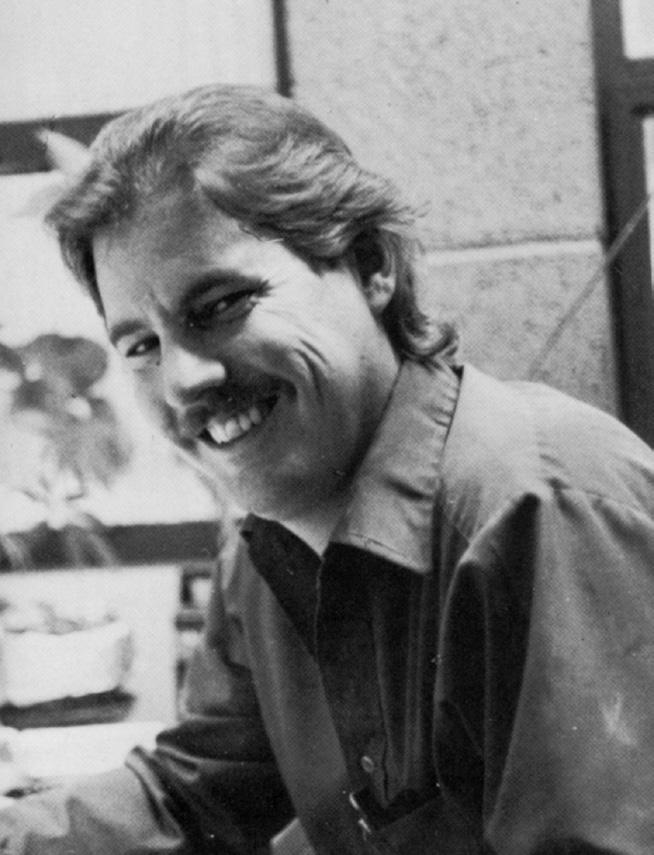

hmc.edu/in-memoriam/gary-evans

Having had excellent mentors throughout her own academic career, Jessica Wu pays it forwardWritten by Kristin Baird Rattini
“i came to harvey mudd because of my commitment to educating the next generation of scientists,” says Yi-Chieh (Jessica) Wu, associate professor of computer science. “One of my favorite parts of this job is working with interested undergraduates to tackle challenging problems and make original contributions in computational biology. I am honored to receive this award.”
In February 2023, Wu was recognized with the 2023 Undergraduate Research Faculty Mentoring Award from the Computing Research Association’s Education Committee (CRA-E). The prestigious award recognizes “individual faculty members who have provided exceptional mentorship, undergraduate research experiences and, in parallel, guidance on admission and matriculation of these students to research-focused graduate programs in computing.” Eligible nominees must be full-time faculty at North American institutions, and only two or three awards are given each year. Wu received her award at the Association for Computing Machinery Awards Banquet in summer 2023.
“Jessica is an extraordinary mentor to her research students. She invests so much time, energy and care in working with her students to prepare them to engage in original and creative work,” says Ran Libeskind-Hadas, past Harvey Mudd computer science professor and department chair and now the founding chair of the Department of Integrated Sciences at Claremont McKenna College. He worked closely with Wu for many years at HMC and nominated her for the CRA-E Award. “She has high expectations and provides a high level of support to help her students thrive.”
A continuously productive researcher during her time at Harvey Mudd, Wu heads a research program that develops and applies computational and mathematical models to analyze evolutionary relationships among genes and among species. Over the past decade, Wu has mentored 29 undergraduate research
students. Twenty-eight have graduated, and 10 have gone on to top PhD programs. Eighteen students are co-authors on nine distinct papers in visible and respected venues in computational biology.
Wu says, “Many of my students use their experience to determine if they want to pursue graduate school, so I have a responsibility to provide an authentic research experience. I am seeing some of my early students now on the academic job market or starting their careers as professors. It is a joy to watch their growth and trajectory into independent researchers.”
Wu’s thoughtful approach impacted Jennifer Brennan ’16, now at Google Research. Brennan says, “The research I did with Dr. Wu provided a valuable bridge between the highly structured coursework of the undergraduate curriculum and the open-ended nature of a PhD.” Brennan and her partner in Wu’s lab were able to choose among several research projects, each using a different set of skills and tools. Wu scoped the projects so that they required reading only one or two background papers, a great foundation for the more in-depth literature review Brennan conducted in her PhD program at the University of Washington. Wu also modeled the importance of collaboration in research when she asked a professor from the math department to share his expertise in graph theory. “This exposure to research as a collaborative, interdisciplinary undertaking made me more enthusiastic about pursuing a PhD,” Brennan says.
Wu describes herself as a holistic mentor. While she would love to have her undergraduate students work with her over multiple summers, she encourages them to broaden their exposure and experience by working with another professor or completing an internship. “If it turns out they find another research area or industry experience more rewarding, that’s great that they have concrete personal experiences on which to base their decisions,” she says.
Wu feels “extraordinarily privileged” to have
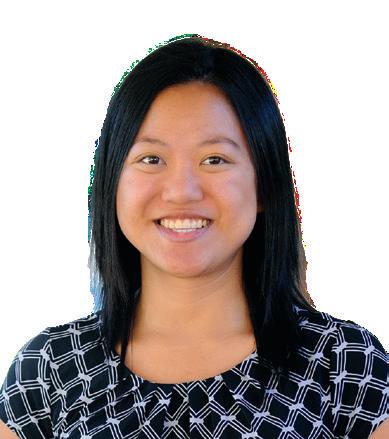
worked with excellent mentors throughout her own academic career, from her undergraduate studies at Rice University through her PhD program at MIT. She says, “My mentors were supportive while always being honest about my strengths and areas for improvement. Because of them, I realized that I wanted to go to graduate school, become a professor and join a small liberal arts college. I am grateful for their guidance and for the opportunity to pay it forward.”
Wu’s passion for undergraduate research mentoring extends beyond her own research program by empowering other faculty to become better undergraduate research mentors. She offers junior faculty advice on how to recruit students, organize research labs and sustain research through the semester. She talks from experience about finding both internal and external funding: She was a recipient of the prestigious National Science Foundation Faculty Early Career Development Grant in 2018. Wu has also helped colleagues broaden their networks across the 7Cs and at other institutions.
Among the evidence considered by the CRA-E award committee is the diversity of the students mentored, a priority for Wu. “I believe it is important to support communities that are underrepresented in computing,” she says. “Literature has shown that providing hands-on experiences with computing research can substantially impact a student's sense of belonging. While systemic problems still exist, I hope I am playing some small part in helping students find and follow their passions.”
More than 175 students and nearly 45 faculty participated in the 2023 Summer Research Program. Projects ranged from fly health to animal-robot interaction. Here is a sampling of summer research activity.

1. Mitochondrial Protein Degradation in Fly Health
Advisor: Jae Hur, associate professor of biology
Students: Chadinthon “Minnie” Kittivorawong, Joshua Zhong, Malina DiBlasi
Professor Hur’s research teams have been studying a protein called ClpXP, which acts like a cleanup crew inside cells. Its job is to break down and remove damaged proteins, making way for new and healthy ones. The team found that ClpXP is especially active in the mitochondria, the cell's powerhouses, where a lot of damage linked to aging happens. In earlier studies, scientists found that a bit more ClpXP could make flies live longer. Now, they’re exploring in more detail how this protein affects the mitochondria. It seems that having more ClpXP not only helps get rid of damaged proteins but also reduces an important protein complex related to metabolism in the mitochondria. The researchers are digging deeper to determine what role increased protein degradation and decreased metabolic activity might have on the health and lifespan of flies.
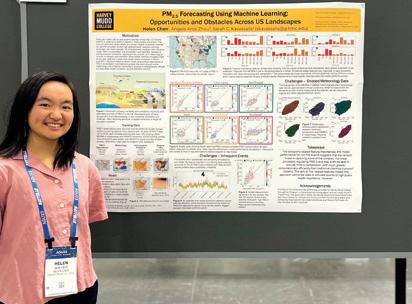


2. PM2.5 Forecasting Using Machine Learning: Opportunities and Obstacles Across U.S. Landscapes
Advisor: Sarah Kavassalis, assistant professor of climate and chemistry
Students: Helen Chen, Angela Zhou (Scripps)
Exposure to particulate matter less than 2.5 micrometers in diameter (PM2.5) presents profound health and environmental implications, driving the need for appropriate representation in air quality and Earth system models of all scales. Using machine learning, the team demonstrated a computationally efficient alternative to mechanistic PM2.5 prediction across diverse U.S. landscapes. Their approach makes highaccuracy predictions with significantly reduced computational needs. Data-driven predictions have essential limitations, though, particularly in areas of disparate data density, changing photochemical production regimes and disruptive phenomena such as wildfires.
3. ML Pipeline Optimization When Querying Video Data
Advisor: Arthi Padmanabhan POM ’14, assistant professor of computer science
Student: Alejandro Wang
While machine learning is seeing explosive growth, it can often be difficult to use, requiring knowledge of several models, data formats and frameworks. For example, if one wanted to respond to an Amber Alert using automated video analysis on traffic footage, they would need to string together at least a model that could detect cars and a model that could read license plates. Over the summer, Wang worked on making such complex, realistic queries easier to run and more accessible for people without a machine-learning background. He built a framework for turning queries from an easyto-use query language into a directed acyclic graph of machine-learning tasks.

4. A Robotic Test Bed for Studying Hunting Behavior
Co-advisors: Alberto Soto, postdoctoral scholar in interdisciplinary education, and Chris Clark, director, Lab for Autonomous and Intelligent Robotics, professor emeritus of engineering Collaborator: Tessa Solomon-Lane, assistant professor of neuroscience, Keck Science Department
Students: Alisha Chulani, Emily Barr, Holly Chen, Angelina Rodriguez
Researchers sought to build an experimental system using robotics and computation to better understand animal behavior, specifically to determine if the behavior of animals, in this case fish, is either influencing the behavior of a robot or the behavior of the robot is influencing the behavior of the animals. A small, wheeled robot under the fish tank was attached magnetically to a fishing lure that resembled a small bait fish that moved inside the tank when the robot moved. Using videos from an overhead camera, students witnessed the robot responding to the position of the fish and the fish responding to the movement of the robot.
5. Doppler Shift-Based Vehicle Data Transmission
Advisor: Kash Gokli, Oliver C. Field Professor of Manufacturing Practice and Engineering Economics and director of entrepreneurship initiatives
Students: Devon Overbey, Xander Fries, Pierce Gruber
The entrepreneurial startup, Axolotl Audio was formed by three engineering students who seek to increase road safety and democratize traffic data through innovative solutions to age-old problems. Leveraging Doppler-based audio analysis, they have developed an intricate microphone amplification circuit, overcoming voltage challenges and noise interference. They are refining algorithms for speed extraction via the Doppler shift, encompassing data collection, signal enhancement, frequency analysis and precise speed calculation. This pioneering approach will save lives, enhance road safety and benefit society while significantly reducing the financial burden associated with conventional data collection methods.
Caltech’s Schmidt Academy for Software Engineering is a postbaccalaureate program in software engineering launched in 2019. Participants are CS graduates interested in software engineering who have strong science fundamentals. The scholars are embedded for one to two years with research groups, are mentored by senior software engineers and receive industry-competitive salaries. Harvey Mudd CS professor Katherine Breeden, a Caltech graduate and member of the Schmidt Academy advisory board, has helped facilitate the collaboration.
When new Schmidt Scholars arrive on campus in late July or early August, they have already been assigned to labs and made a commitment for a year’s work with the option to continue for a second year. (Most scholars spend two years at Caltech.) The first thing they do is meet their fellow Schmidt Scholars and their mentors, Donnie Pinkston and Dave Rumph. This is done via a bootcamp run by Pinkston—an intensive version of Caltech’s CS 130, a software engineering course offered during winter term. Scholars practice designing and testing small-scale projects. Grad students can also take the class, for credit or not, and those grad students who will be working closely with a Schmidt Scholar are especially encouraged to do so.
David Pitt ’23 was excited to begin his Schmidt Scholarship in August's boot camp. “I worked full time my senior year in addition to school, and I got a taste of working in industry, so I
decided I wanted to try something else for a year,” he says. Pitt will be working on an AI project involving “a new breed of neural networks called physics-informed neural networks.”
After bootcamp is completed, Schmidt Scholars meet every week, taking turns presenting progress on their projects. In addition, they meet individually with either Rumph or Pinkston every two weeks, or more often if needed. As an initial step, the scholars interview members of their lab to learn their software requirements. Then, says Breeden, “They build the scaffolding. They identify deliverables for the first year of work and map out a practical timeline.”
Because the Schmidt Scholars are embedded in the labs that will be using the software they develop, “the information exchanges happen on a daily basis,” David Van Valen says. “Within six months, they know enough about the science to be able to really move forward on the things they've been tasked with.”
Schmidt Scholars do encounter some challenges that computer science grads rarely confront in industry. “A lot of the scholars are doing ‘software archaeology,’” Breeden explains. “They’re looking at scientific software packages that might have been written 20 or 30 years ago in languages that we don’t teach anymore. They have to become proficient in FORTRAN, for example, or they need to read through flight software from a satellite launched decades ago.”
Excerpted with permission from Caltech. Read the full article, “Software in Science” at bit.ly/3S9zZ18.
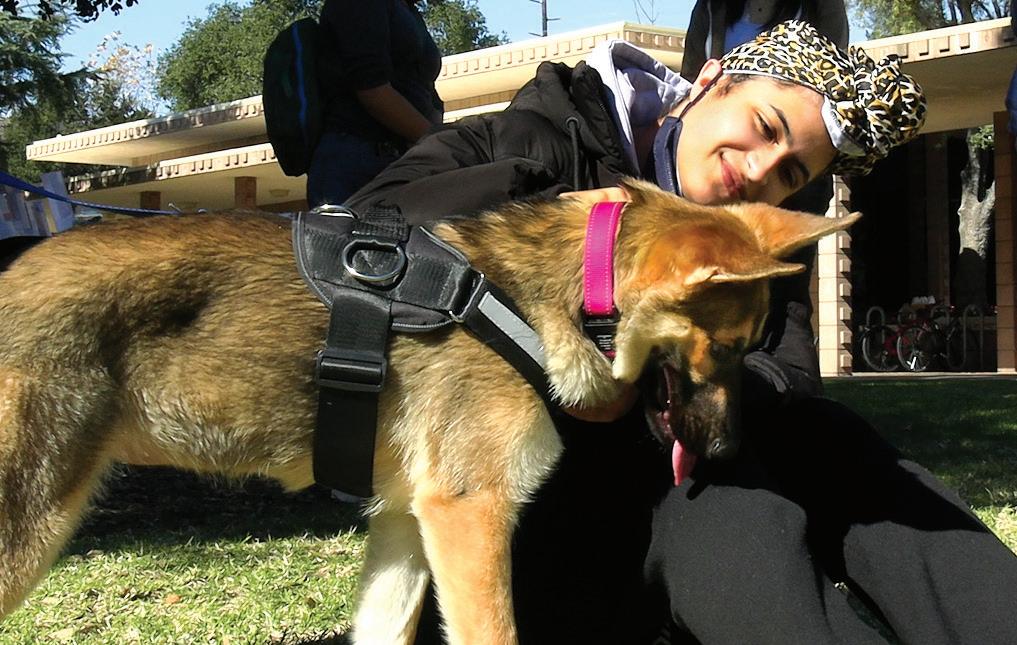
HMC Leadership Awards embrace the many forms of leadership at Harvey Mudd College. Mudders Making a Difference (MMAD) received the 2023 award for Outstanding Student Organization. Georgia Klein ’24, Linde Dorm president and MMAD co-president, describes the group.
How many students are involved with MMAD?
We have nine students in leadership, including the two co-presidents, Sydney Neibert and me. Outside of leadership, we have 320 students on our email list, including students who are no longer at Mudd, so this is not really representative of how many different people attend our events. For big events, we promote them to the entire student body, as well as sometimes faculty and staff.
What are your weekly meetings like?
We meet on Sundays to plan for the events that we are working on. Each student picks a project to work on alone or with one to two other students, and we meet each week to discuss what progress we made that week and support each other’s projects. It’s like doing a team check-in! We decide on projects at the beginning of the semester, repeating projects that we have done in the past and allowing for students to propose and implement new projects.
What events have you hosted recently? What do you have planned?
We’ve done dog walking with Priceless Pets and are planning events with Baldwin Park tiny homes program, a blood drive, donating shoes to the Upland Unified School District through Shoes that Fit, an event with Habitat for Humanity, gathering donations at Jay’s Place to bring to Foothill Family Shelter and donating leftovers from the Hoch through the Food Recovery Network.
What event(s) have stood out as really resonating with participants?
I think people really like having dog walking near campus, having the blood drive come to campus and being able to donate food at Jay’s which goes to Foothill Family Shelter.
How does MMAD impact the rest of campus?
We help community members participate in community service and contribute to the local area. As a Mudd student, it is often hard to get off campus and participate in the wider community. Through MMAD, students are able to volunteer off-campus as well as donate or contribute to projects while on-campus that benefit the wider community.
“put your thumb here and your fingers there,” my dad explained. I was four years old, and he was teaching me to count the 10,000 Chinese Yuan in bills that he’d placed on the table before me. However, I was not interested in business. Instead, the process of counting itself interested me more. At that time, I never knew that I would enter the beautiful world of mathematics and stay for years.
My relationship with math took off after a failure: My team earned only a participation award in the high school math contest in modeling in 10th grade. Still amazed to discover matrices’ god-like ability to solve many seemingly unrelated things, I decided to dive deeper. Later, I learned how each coefficient, each assumption matters: with a small dataset, a time series model may be better than a more advanced-seeming neural network. Sometimes linear programming has no solution or requires 1,000 years to run the program.
I realized definitions, not proofs, are the most essential part of math at the Canada/ USA Mathcamp. After camp, I researched the number of triangulations on a Mobius strip, the only finite type in quasi-cluster algebra, with n marked points. The research seemed easy at first; however, as n became larger, the problem haunted me. Was there a pattern hidden in the sequence? I tried new approaches daily, gluing and transforming the Mobius strip. After months of work, my mentor, my co-researcher and I came up with an iterative formula. However, the formula wasn’t “elegant” enough, so we took another two months to find a cleaner way to express it. The more we knew, the more problems arose, so the research never ended in discovering the bases of quasi-cluster algebra. From counting the amount of money to counting triangulations on a Mobius strip, the eternity of math feeds my spirits.
As I entered Harvey Mudd College, I focused more on analyzing computer science algorithms. I joined the AMISTAD Lab to research the vectorization of bias for continuous machine learning models. The theoretical aspects of the problem were intriguing, yet
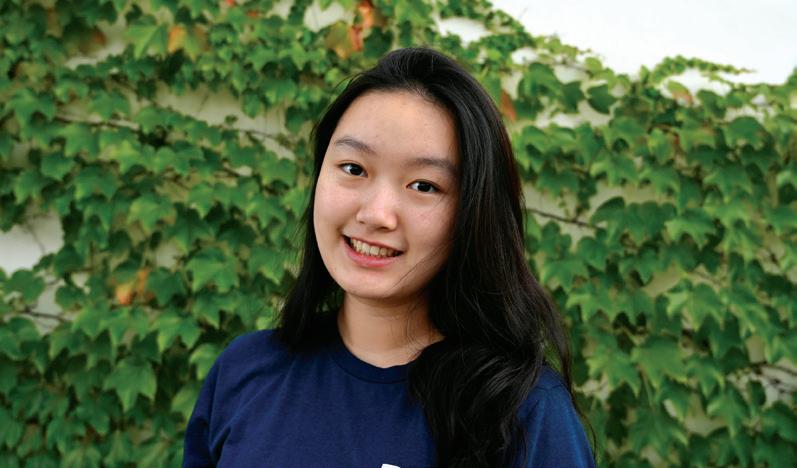
“ From counting the amount of money to counting triangulations on a Mobius strip, the eternity of math feeds my spirits.”
–LAURIE LUO ’25
the sheer magnitude of data presented unique challenges. This led us to innovative approaches in representing our continuous search space: by making thoughtful assumptions and justifying simplifications, we were able to represent our findings more effectively, ultimately storing these vectors as probability distributions using kernel density estimation.
Currently, as an AI research intern at a biotech company, I delve into the complexities of genomic data, seeking harmony amid its variations. My days are spent in meticulous analysis, modeling patient outcomes through the lens of longitudinal whole genome sequencing and refining the intricacies of bioinformatics pipelines for enhanced efficiency. As each puzzle piece falls into place, my
anticipation grows for the next chapter of my journey as a quantitative research intern. I look forward to exploring new challenges, blending my love for mathematics with the practical demands of the industry, and continuing my pursuit of elegant solutions in the tapestry of data.
Laurie Luo ’25 is a CS and math major, fully immersed in the “beautiful world of mathematics.” She’s co-authored papers about quasi-cluster algebras, Kac-Moody algebras and, recently, “Number of triangulations of a Möbius Strip,” which was published in 2023 in the mathematics journal Involve.
Final projects in Microprocessor-based Systems (E155), taught this fall by Josh Brake and Tina Smilkstein, allow students to apply their new skills in digital design to a moderately sized problem as part of a two- or three-person team. Projects used both field programmable gate arrays and microcontroller units to perform a function that is useful or interesting.

James
The team built a decorative Iron Man helmet with functionalities seen in the movies. The system reads its inputs from a keypad and a gesture sensor using the field programmable gate array (FPGA) and microcontroller (MCU) respectively. A motor mounted inside the helmet allows the face mask to be opened and closed. The eyes are made up of multiple 8x8 LED matrices. The FPGA and MCU communicate with each other and use the inputs to determine when to open and close the helmet as well as what to display on the LED eyes.

Students implemented a drumming rhythm game using a microcontroller and FPGA that interface with piezo sensors, a speaker and a 32x32 LED matrix display. Players listen to the music and watch the beats scrolling down the display to time their hits on the two drums (left and right) correctly. There are three rounds, and each successive round is faster than the previous. If the user passes all three rounds (i.e., hit at least 50% of the notes in each round), they win.
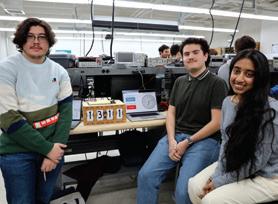
Nithya Yeluri ’25, Dimitri Avila ’25, Javier Perez ’24
The team aimed to design and implement a distinctive split flap display clock featuring four flap units to showcase the current time in a 24-hour format. The display configuration, structured as “hour hour: minute minute,” provided an intuitive and visually engaging representation of the current time. The heart of the clock’s movement was a precise stepper motor, allowing for controlled and accurate transitions between time intervals. In addition to timekeeping, they incorporated an LED display, which displayed a sun and moon emoji, offering an at-a-glance indication of the current time of day.

Kaitlin
Snake on VGA is a project designed to play around with video protocols while displaying a classic game and was inspired by the look and feel of classic arcade-style games. “The idea of displaying it on a regular, run-of-the-mill monitor (provided it has a VGA port, a less common protocol nowadays) was enticing.”
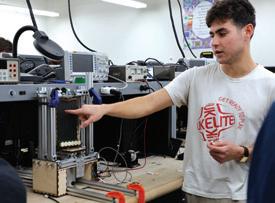
Lawrence Nelson ’24, Cecilia Li ’24, Martin Susanto ’24
Students created a playable maze game inside its own cabinet. The maze game has a timer that introduces a win/lose condition and allows the player to navigate the maze using the Wii Nunchuk controller. The LED matrix displays the maze and plays all animations.

ryan o’hara’s first exposure to environmental work took place during an internship at NASA’s Kennedy Space Center, where he helped develop an algae-based, lifesupport system for the International Space Station and future lunar colonies.
“Our civilization is currently hurtling toward a catastrophic ending due to the climate crisis,” O’Hara ’24 says. “I want to do my part to rewrite that ending and build a better future for the communities I care about and those that will come after me.”
From the looks of things, O’Hara is doing more than his part. The double major in environmental robotics and computer science/ mathematics is a 2023 Astronaut Scholar and the youngest-ever chair of the Association of Polar Early Career Scientists, which works with the United Nations on climate policy. Dec. 12, he traveled to Dubai to attend COP 28, the UN’s annual summit for world leaders to gather and create global policy to address climate change. While there, he spoke about his environmental nonprofit work as well as the $100,000 776 Fellowship he received from Reddit co-founder Alexis Ohanian. That award will allow O’Hara to spend the next two years building an opensource, semi-autonomous robot that is able to identify and collect purple sea urchins—which are devastating California’s kelp forests—from near-shore ocean ecosystems.
Why did you decide to focus on purple sea urchins?
Purple sea urchins have, due to a combination of climate change-driven factors, exploded in population in the past decade and have been largely responsible for an over 97% decrease in kelp forests off the West Coast. Kelp is incredibly important to ecosystem health. It provides shelter and nutrients to local fauna
and buffers against many marine consequences of climate change. And, it serves a major role in the U.S. economy, so we’re hoping that this project will help remediate California’s kelp forests. This project got picked up by HMC’s Entrepreneurship Clinic Program, so we’ve been making a ton of progress recently.
You’ve been involved in quite a few environmental and climate-change research projects in addition to your time at NASA. Can you talk about those?
I’m currently finishing a project at Ames Research Center, which aims to build a machinelearning model capable of analyzing and predicting contrail formation from commercial aviation. In spring and summer 2021, I lived on a research vessel for a two-month Atlantic Ocean expedition (with Boston University, the Woods Hole Oceanographic Institute, and the Sea Education Association), which studied the effects of climate change on lanternfish population dynamics and migration patterns. And in summer 2022, I helped develop a more efficient method for mass producing microrobotic environmental sensors at the University of Washington.
One of the major things I’ve learned from this work is that the oceans experience some of the most severe consequences of climate change but seem to be neglected in global climate policy and talks. As a result, I wanted to use my knowledge of this space and technical expertise to fill this perceived gap in the climate movement’s work.
How do you juggle course work and your fellowship project?
Fortunately, Clinic is the only significant course I still need to complete to graduate, and Mudd’s new Entrepreneurship Clinic Program will allow me to fulfill this requirement while also working on the fellowship. As a result, I’ll be able to work full-time on my project and stay at Mudd part-time in order to receive my- degree next spring. After graduation, I plan to pursue a PhD in earth sciences and engineering then embark on a research career (entrepreneurship or government work) in climate tech and climate change solutions.
What do you do in your spare time?
I play piano for the Scripps music performance program and regularly perform around campus (I provided background music for President Klawe’s going-away dinner.). Over the past year, I’ve pursued two climate-based, independent projects: one in which several friends and I are working to program, train and develop a neural network capable of making predictions about aerial pollutants around the world and another where I built a solar-powered autonomous system out of my dorm room, which used algae and robotics to extract and store carbon dioxide from the atmosphere.
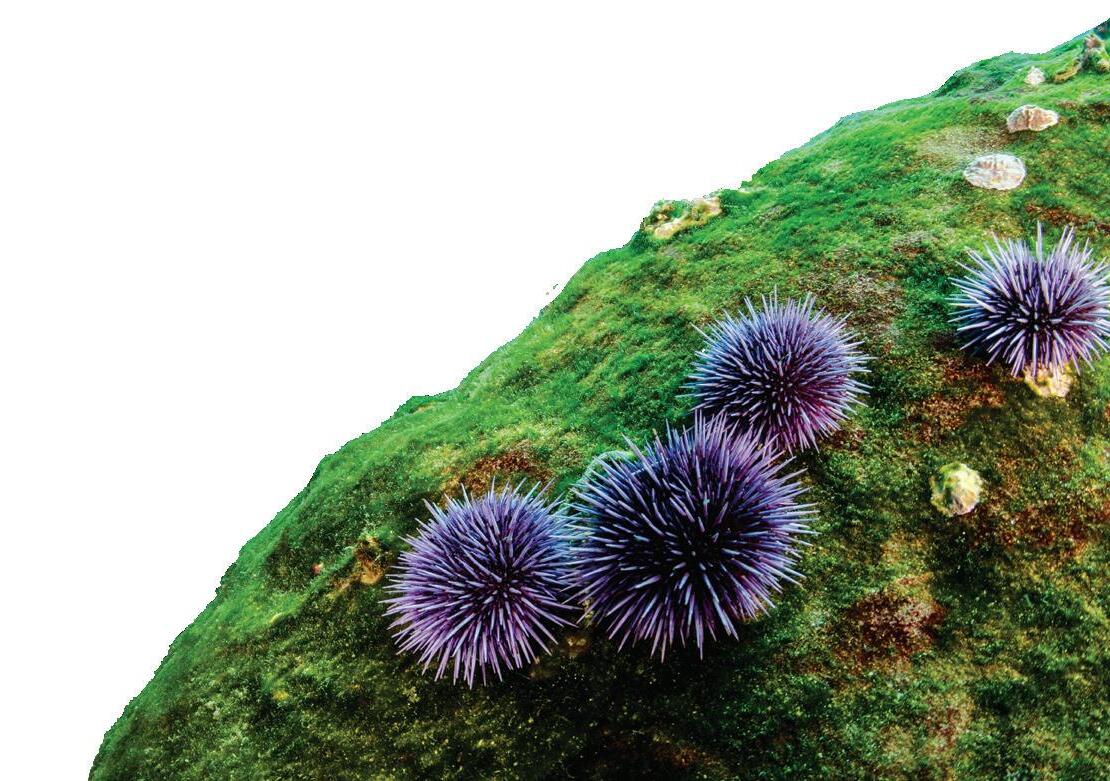


when nicholas seet enrolled at harvey mudd college, he was laser-focused on the hard sciences. But one of the most valuable lessons from his time on campus was the value of soft skills, especially networking.
“I learned the importance of interacting with colleagues and not being the stereotypical solitary engineer,” he says. “The more people who know what you’re doing, the more likely they are to come up with solutions that you hadn’t even thought of.”
“ Always keep asking, ‘What else can I do? What else can my technology do to help people solve problems?’ That’s when the entrepreneur mentality kicks in. Solving problems is the name of the game.”
–NICHOLAS SEET ’99

That lesson has been crucial throughout Seet’s successful entrepreneurial career, but especially in his current endeavor: Undesert, a dramatic pivot from his Silicon Valley tech roots to climate change mitigation. Working with diverse partners ranging from the Bureau of Reclamation to Shell Global, Seet is using Undesert’s patented thermal desalination device to transform desertified land into forest and extract carbon from the atmosphere, with his sights set on no less a prize than the $100 million XPrize for Carbon Removal.
Entrepreneurship wasn’t part of Seet’s original plan when the Chinese-born Australian applied
to Harvey Mudd, but several signposts along his early academic and career path pointed him in that direction. Upon moving to the United States, Seet spent time with his uncles Richard and Charles Ying, cofounders of Atex, a pioneering global hardware and software supplier to the publishing industry. His interest was sharpened in the introduction to entrepreneurship class taught by the late Gary Evans, professor of economics. “That really opened my eyes to the opportunities for entrepreneurs coming out of college,” he says.
Upon graduating in 1999 with dual degrees in engineering and economics, Seet worked as a systems analyst with Deloitte Consulting in
Silicon Valley during the first dot-com boom. “Everyone I spoke to had the entrepreneurial bug,” Seet says.
So did Seet; he left Deloitte after a year. In 2001, he started working on what would become his company Auditude, whose first iteration tracked ads on TV and radio to make sure those ads were being played correctly. While earning his MBA at the UCLA Anderson School of Management, he crafted the Auditude business plan that won the Rice Business Plan Competition in 2005. Seet adapted this company with the changing tech times, extending Auditude’s technology to identify unauthorized use of copyrighted videos online. The company caught the

attention of Adobe Systems, which bought Auditude for a nine-figure sum in 2011.
Seet settled into semi-retirement mode and settled in Los Alamos, New Mexico. He started his family (he now has four children), taught entrepreneurship courses and pursued various ideas that sparked his interest.
The initial idea for Undesert came in 2019 during a drive through the desert shrublands near Alamagordo, New Mexico. He’d been growing more interested in climate issues, particularly the water shortages across the Southwest. “I thought, ‘There’s a lot of empty
land here, a lot of sun and a lot of underground water from the Permian Basin,” he recalls. “What can we do with it?’”
At the Bureau of Reclamation’s Brackish Groundwater National Desalination Research Facility in Alamagordo, he started familiarizing himself with the latest desalination techniques to transform dirty water—such as the Permian Basin’s brackish underground reserves—into clean water. He connected with Hill Kemp, a researcher whose solar-powered desalination technology had shown promise in transforming one acre of desert into an oasis in the United Arab Emirates.
Kemp’s invention, called the solar wastewater purification (SWAP) device, heats— but doesn’t boil—wastewater, such as brackish water and seawater, and condenses it into a stream of ultra-pure water at up to 50 liters per square meter per day. (The remaining dry salt condenses into bricks.) Each SWAP device can be produced in 24 hours for less than $1,000.
“I’d never seen such a technology with such little environmental impact,” Seet says. “But the challenge was, how do we take that to market? What are the opportunities for clean water?”
Kemp and Seet joined forces to create Undesert. As he learned at Harvey Mudd, Seet seized every opportunity to brainstorm the potential of Undesert with others. While participating in the Mass Challenger Accelerator in Houston, Seet discovered that oil and gas companies every year generate vast quantities of what is called produced water: seawater or brackish water that’s injected underground to extract oil and then left underground.
He then took the idea of desalinating produced water to Shell Global’s Game Changer Accelerator. “It was there that the solution presented itself to me,” Seet says. “There is the huge amount of wastewater, either from produced water or ocean water. There’s huge amounts of unused land around oil pipelines or otherwise degraded land in New Mexico and Texas. Why don’t we clean up this dirty water with our desalination technology and grow trees on degraded land?” He ran the numbers: Afforesting just two percent of the world’s
desertified land would absorb enough carbon to significantly reduce climate change.
Undesert’s pilot site in the New Mexico desert started with 16 trees and has since grown to 250, a mixture of Afghan pines and Ponderosa pines selected in consultation with researchers at New Mexico State University. The company’s premise showed enough promise to earn Undesert the status of “qualified competitor” in the $100 million XPrize for Carbon Removal. “To win the XPrize competition, you need to demonstrate technology that can capture 1,000 tons of CO2 by the year 2025,” Seet explains. “For us, 1,000 tons is equivalent to planting five acres of pine trees.”
Seet plans to collaborate with the Brackish Groundwater National Desalination Research Facility to scale up the site toward the five-acre goal and create a sizeable domestic opportunity for carbon offsets, in which a corporation— say, a petroleum company—or individual compensates for their own greenhouse gas emissions by supporting projects that reduce or store carbon emissions. “The offset market is still very immature and there’s not enough offsets to go around,” he says.
Seet has his sights set far beyond the Permian Basin. “After we prove our technology in the U.S., we can license it to governments and global corporations that could potentially build out elsewhere, such as in the Middle East,” he says. “The technology could change vast amounts of empty desertified land in those regions into forests, not just for carbon capture but to create hospitable regions for human habitation.”
Water access. Carbon capture. These are among the largest climate problems of our times. But entrepreneurship, at its heart, is all about problem solving. “Always keep asking, ‘What else can I do? What else can my technology do to help people solve problems?’”
Seet says. “That’s when the entrepreneur mentality kicks in. Solving problems is the name of the game.”
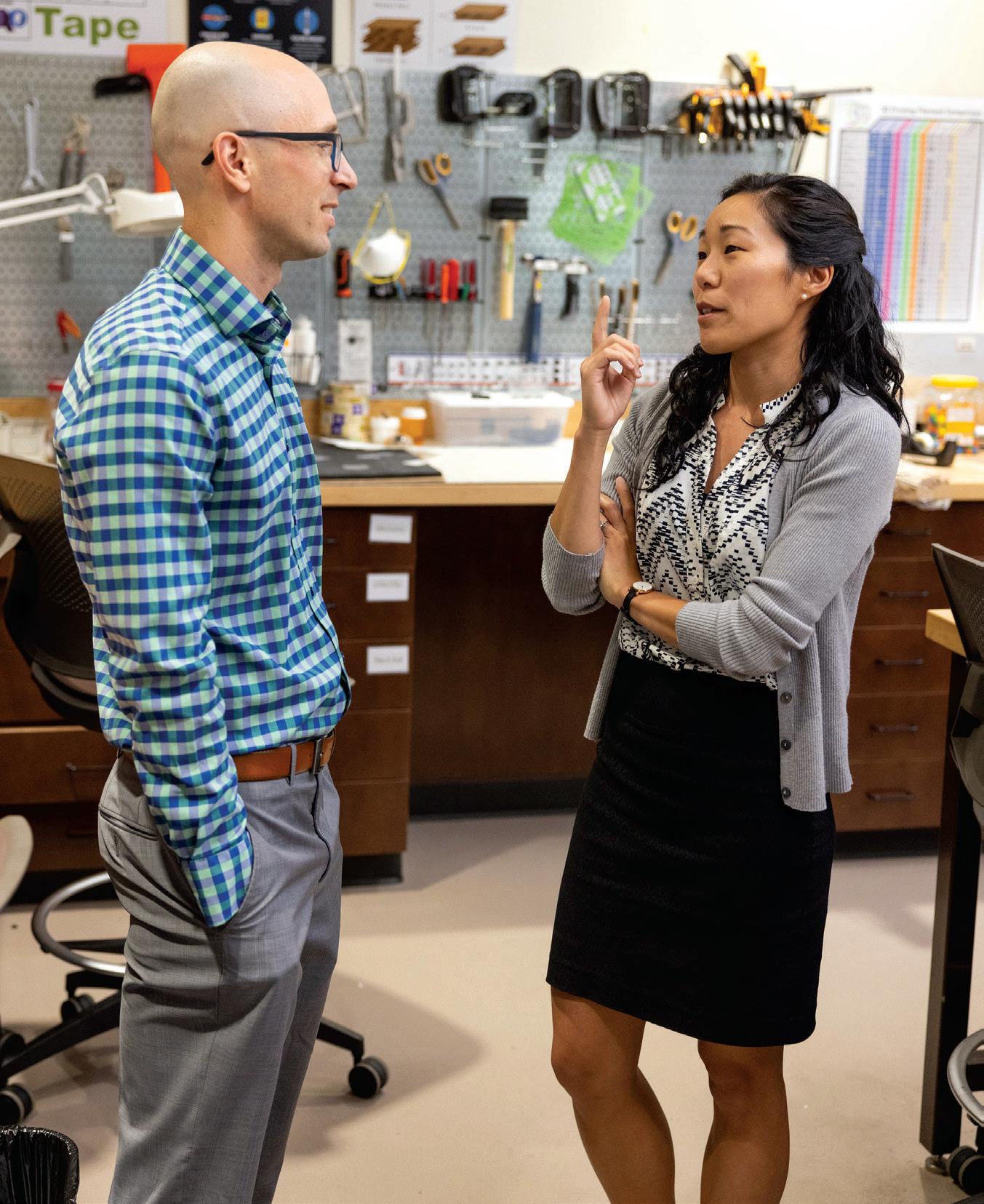
although they didn’t overlap as students at Harvey Mudd, alumni Diana Chen ’13 and Gordon Hoople ’08 are now close colleagues—and friends—as associate professors of engineering at University of San Diego (USD). Together, shortly after they joined USD in 2016, Chen and Hoople helped establish a new department at USD’s Shiley-Marcos School of Engineering, one that underscores the intersection of engineering, the humanities and societal impact.
Both Chen and Hoople emphasize how crucial it is for budding engineers to understand that the field is inherently socio-technical, and that teaching engineering requires a holistic approach. They officially launched USD’s new Department of Integrated Engineering in fall 2017.
As part of this endeavor, they also aim, through
their own collaborative research, to increase inclusivity in a field that has historically lacked improvement and advancement in diversity, equity and inclusion.
For six years and counting, the Integrated Engineering department has grown from eight students to now being at full capacity (55 students) in all of the department’s course offerings. Students in the program select from four concentration areas—biomedical engineering, embedded software, sustainability, and engineering and the law—or they work with a faculty member to create an independent plan of study as a concentration.
Chen and Hoople discuss the new engineering curriculum they are co-designing at USD and their viewpoints on incorporating socio-technical thinking into today’s engineering classroom.
How did you both get involved in starting the new Department of Integrated Engineering at University of San Diego?
Hoople: The dean and the department chair knew that they wanted to start a holistic engineering program, something I recognized as very similar to Harvey Mudd. The reason we were hired in large part is because of our background at Harvey Mudd—the background in the general engineering degree and the breadth of focus there. That all really was very clear in both of our applications and in both of our interviews.
As an undergraduate, what attracted you to Harvey Mudd and how has the HMC curriculum informed the work that you’re doing now at USD?
Chen: Harvey Mudd’s mission—the idea of caring about impact on society—and the fact that the humanities is built into the curriculum is what I really liked about its engineering program. My humanities courses were my favorite classes. Gordon and I have a shared history of caring about the Harvey Mudd mission but then graduating and not knowing what to do with it. Our humanities and our engineering education at Mudd were so separate. We’ve taken that and we’re integrating the humanities and engineering a bit more in the program that we have at USD.
Hoople: The Clinic Program is what really drew me to Harvey Mudd, and the breadth of the degree because it wasn’t narrowly tracked and specifically focused. Interestingly now I’m very involved in our equivalent of the Clinic Program at University of San Diego. I’ve done a lot of work with that program and made it more interdisciplinary and have brought teams together across not only our department in integrated engineering but also the electrical engineering and the mechanical engineering departments.
What makes this new department so unique?
Hoople: Our program was explicitly set out with this foundation of bringing social and technical together. We already had a mechanical engineering department. We already had an electrical engineering department. We really wanted to bring in USD’s mission, which is all about our Catholic intellectual tradition and social justice, into the engineering classroom and think about how engineers impact society

and how we can actually make the world a better place because, too often, engineering is completely devoid of that societal context.
How is that being incorporated into the classroom?
Chen: What stands out the most about our program is that we have two required courses in how social justice and engineering intersect. At the lower level, I’ve designed a User-Centered Design course that explores diversity, privilege and oppression, and how engineers really should be thinking about how our designs impact people and society. At the upper division, Integrated Engineering students take a deeper dive into analyzing unequal power relationships within engineering as a practice and critiquing
historical and sociopolitical factors that affect who is included in engineering.
Hoople: We have an energy course that we’ve developed through an NSF grant award that explicitly is looking at how do we draw from a collection of teaching techniques, called culturally sustaining pedagogies, to create a more inclusive environment in the classroom, and we did it in the context of energy.
This brand-new course puts things like renewable energy at the forefront of the course rather than talking about fossil fuel-based energy supplies, which is often done in a mechanical engineering thermodynamics course, for example. We set out to change the ways we talk about engineering problems,

for example, by having more people-forward examples and including a more diverse set of viewpoints. Part of the class is a discussion on sustainability. Not only do we look at the definition of sustainability from the 1970s that came out of the UN, but we are also looking even further back to indigenous conceptions of sustainability and try to understand how those can help us as we search for more sustainable approaches to engineering.
What current research dovetails with your work in curriculum design?
Chen: We are working together on a racial equity project, which I am the primary investigator of, that’s examining “Whiteness” in engineering culture. Why is the default to consider women
“ We really wanted to bring in USD’s mission, which is all about our Catholic intellectual tradition and social justice, into the engineering classroom and think about how engineers impact society and how we can actually make the world a better place because, too often, engineering is completely devoid of that societal context.”
–GORDON HOOPLE ’08

and Black, Indigenous and other people of color (BIPOC) to be “underrepresented” in engineering, instead of questioning why White men are “overrepresented” in engineering, when there are twice as many White men in the engineering workforce than there are in the general population? Our project asks, “What about our culture is causing engineering to be an exclusionary space?” Our last grant together, which Gordon was the principal investigator of, explored the use of inclusive pedagogies in our engineering courses in order to broaden participation and make engineering a more racially equitable space. Our current grant builds on that and our goal now is to target faculty. Faculty are often the gatekeepers of engineering culture, and we are at the frontlines as mentors and authorities of engineering curricula. If we can help engineering faculty across the nation to develop a critical consciousness, our hope is that these faculty will become change agents, influencing their students, their colleagues and the very fabric of their institutions’ cultures to begin to dismantle forces of systemic oppression in engineering higher education.
What exactly is meant by socio-technical engineering, and why is it important in today’s classroom?
Hoople: There was a great paper from a few years ago that included interviews with engineers at
various stages in their careers. If you talk to an engineer who has just graduated from school, they say, “I wish I had taken one more technical elective related to the job I’m doing right now.” You talk to them 10 years later, they go, “You know, I wish I had taken one more business course because now I’m more of a manager,” and you talk to them 10 years after that, they say, “I should have taken more humanities classes while I was in college because I see now that engineering is really just about people and about how they work together.” So, engineering at its heart is not about being able to do math. That’s one of the tools that’s in our toolbox. It’s about being able to work with people and come up with solutions that serve society, and that’s what we need to be teaching our students.
Chen: What both of us really appreciate from our time at Mudd is that we learned how to learn; that was something Mudd was very good at. We’ve taken that and packaged it in our mission statement as a department. We want to teach students to be able to use and find resources. Our goal is that they can go into any discipline after they graduate from our program. They can be engineers, they can be lawyers, they can be doctors, whatever they want to be, but they know how to problem solve and think like an engineer, while still critically evaluating their own impact on society.
The AABOG Spotlight Recognition Award recognizes innovation, leadership and impact through global influence and contributions to society
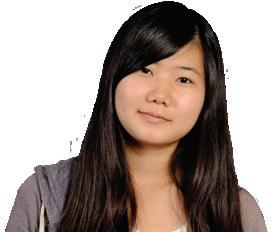
Lee Joon “LJ” Kim ’17 graduated from Harvey Mudd College with a joint major in chemistry and biology. During college, she performed research in organic synthesis under chemistry professor David Vosburg, where she synthesized natural products— or chemical substances produced in nature—that have medicinal properties and learned of her passion for scientific research relevant to human health and pharmaceuticals. This passion was further cultivated during summer research and internships at UC San Francisco and Genentech.
In fall 2017, she started her PhD program at UCLA in the lab of Hosea M. Nelson. During graduate school, she pivoted her research focus from synthesis to characterization of natural products, using an electron diffraction technique that was quickly gaining a lot of interest for its ability to solve 3D structures of chemicals without the need to grow large crystals, which can be an arduous process of trial-and-error. Kim applied electron crystallography to characterize natural products that are difficult to unambiguously determine structures of due to their miniscule amounts. Notable examples include fischerin, a fungal natural product with only a predicted structure based on computational methods, and the lomaiviticins, a class of bacterial natural products whose core structure was corrected using electron diffraction. As the second student to learn electron diffraction in the lab, Kim also trained other students and helped create a course with Nelson.
While receiving samples from collaborators and solving their structures was exciting, Kim realized that she wanted to be involved in projects at a much earlier stage and expand her skill set, working with different samples relevant to human health and learning new techniques. After graduating with a PhD in organic chemistry in 2022, Kim now works at the Lawrence Berkeley National Laboratory under Dr. Greg Hura and Dr. Michal Hammel. There, she is a postdoctoral fellow applying x-ray methods, mainly small-angle x-ray scattering, to characterize biological systems, such as vaccines and proteins, while collaborating with pharmaceutical companies. She hopes to ultimately move to industry where she can be more directly involved with developing pharmaceuticals.
The College holds alumni events in cities across the country.
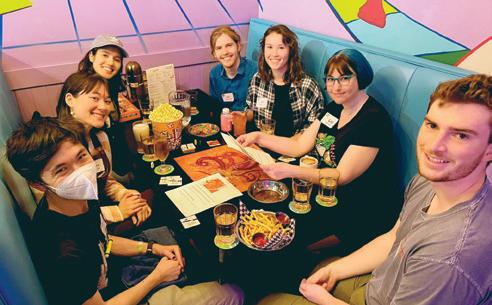
Visit
Feb. 29, 2 p.m. | Galileo Hall

“Building Success with Heart: The Role of Kindness and Curiosity in Venture Capital”
A conversation with Ho Nam ’88, managing director and co-founder of Altos Ventures, and President Harriet Nembhard

Meet up with old friends and make new memories!
Reunion celebrations for class years ending in 4 and 9
Complete the Alumni Weekend 2024 Interest Form to receive a promotional code good for $10 off Alumni Weekend registration—bit.ly/AW24form
Reunion volunteers needed! Email alumni@hmc.edu if you’re willing to help.

Michael Blasgen (engineering) is retired, living in San Diego. He worked at IBM Research for many years and the Sony US Research Labs. He has a PhD in electrical engineering and computer sciences from UC Berkeley and an M.S.E.E from Caltech and is a Fellow of the ACM and a Fellow of the IEEE. He writes, “My wife Sharon SCR ’64 died a few years ago. I keep busy; I collect photographs and am on the board of the Museum of Photographic Art, and am a member of the Photo Council at the Getty Museum. I am a member of the Harvey Mudd Board of Trustees.”
The Foundation for Education Research recognized Steven J. Barker (physics) as a 2023 Friend of FAER Honoree. Steven was lauded for serving as an exceptional mentor to numerous anesthesiologists and investigators, and for making extensive contributions to science in anesthesiology, including his oft lauded work on pulse oximeters. He also continues to aid FAER’s mission to develop the next generation of physician-investigators through generous volunteerism and financial support. Currently, Dr. Barker serves on FAER’s Development Committee.” Steven called the award “the greatest honor of his career.”
Jack Levy (physics) continues to teach political science at Rutgers University, with an additional affiliation at Columbia University, where he teaches one graduate course a year. Jack’s research focuses on the causes of interstate war from a theoretical and historical perspective. He also studies the processes through which states make foreign policy decisions, including the psychology of decision-making. Last year, he received a Distinguished Scholar Award for lifetime achievement from the International Studies Association. He continues to spend countless hours working in his garden and to explore new places around the world with his wife, Kimberly Marten.
Bob Lewis (physics) married Cynthia last May. At the same time, he retired after 25
years on the computer science faculty in the School of Engineering and Applied Sciences at Washington State University.
Nadine Malcolm (math) has been working hard with co-author Dr. Lorien Pratt on The Decision Intelligence Handbook. She says, “Our book is being published by O’Reilly and is currently in early release here: bit.ly/3RrWwHo. Lorien’s earlier book Link: How Decision Intelligence Connects Data, Actions, and Outcomes for a Better World introduced decision intelligence (DI) concepts. The Handbook is a practical guide to the DI methodology. DI goes beyond data insights. It’s a methodology for finding the data, models and human knowledge that show you which actions will lead to the outcomes you want and which leading indicators or KPIs to monitor to keep your decision on track to achieve your outcomes.”
The American Nuclear Society has added to its publication catalog Robert Busch’s Nuclear Criticality Safety: Evaluations, Calculations, and Experiences, which describes fundamentals, applications and experiences in nuclear criticality safety (NCS) with a focus on criticality accidents and lessons learned. The book complements the seminal 1985 text Nuclear Criticality Safety: Theory and Practice by Ronald Knief, also published by ANS. Robert’s volume caters to both students at the undergrad and graduate levels as well as nuclear professionals just entering the criticality safety field. For those with experience in NCS, the book can be a valuable refresher and a means to update their understanding of current methods. Up-to-date material on computer-enabled modeling and computation is included. Robert (physics) has been involved in the NCS community since 1975, when, as a graduate student, he helped organize the first University of New Mexico NCS Short Course. He was made director of those courses in 1989 and grew the program in 1996 with an NCS Short Course series in the United Kingdom. His career at UNM spans 35 years; he is principal lecturer emeritus in the Department of Nuclear Engineering. In 2001, he was recognized by his peers in the ANS Nuclear Criticality Safety Division with the Distinguished Service Award.
Mark Allen ’73/74 (engineering) retired in 2019 after 45 years with Hewlett-Packard and Agilent Technologies. During the pandemic, he acquired a 3D printer and then used it to make a CNC router. Mark says, “I’ve been honing my mechanical engineering skills, learning CAD and printing my own designs. I’m currently working on a garden clock powered by an Arduino, stepper motor and gears designed and printed. Linda PZ ’73 and I have begun traveling post-pandemic. We were in Rapa Nui, Chile, and Argentina this winter.”
Easy Reader & Peninsula Magazine featured Bradley Bobbs (physics) in October and described his talks about quantum physics that include humor and anecdotes and are geared toward lay audiences. One of his most recent talks was at the Redondo Beach Main Library Jan. 6, when he presented “Why a Laser?” and “Lasers I Have Loved.” To learn more about antimatter, multiverses, why Bradley dresses up as Edgar Allan Poe and more, read the article at bit.ly/3Narb9C.
Andrew Lees (chemistry) received the Horton Award from the CARB division of the American Chemical Society for contributions to industrial chemistry. Andrew is the founder and CEO of Fina Biosolutions, LLC (Rockville, Maryland), a company focused on promoting affordable conjugate vaccines, a class which includes vaccines for S. pneumoniae and meningococcal disease. Among his contributions to the field, Dr. Lees developed CDAP chemistry for activating carbohydrate hydroxyls, allowing for the efficient linking of proteins to polysaccharides. The chemistry has helped to reduce the cost of these vaccines as proteins can be directly coupled to CDAPactivated polysaccharides, eliminating many manufacturing steps. He also introduced a low-cost version of CRM197, a genetically detoxified diphtheria toxin commonly used as the protein component of proteinpolysaccharide conjugate vaccines, increasing access to the protein for both basic research and vaccine manufacturers.
Paul Kenney (chemistry) writes, “I’ve been doing synthetic organic chemistry in the service of new DNA sequencing technology, mostly on surfaces these days. Currently at the startup Ultima Genomics. Work in the lab every day, but what I really do is tie dye, another form of synthetic organic surface chemistry with a long history. Synthetic organic chemistry has its roots in the dye industry form the 1880s and tie dye, a form of resist dyeing, has a history going back thousands of years. I have a style of tie dye named after me, ‘Kenney Style’ tie dye. Look it up on IG, Facebook or Google it. I’ve met many people of all ages and backgrounds via the tie dye community. In the end, everything is chemistry.”
Greg Eiden (chemistry) writes, “The family is spreading out; the boys are in Texas and our daughter will be in New York soon. Great adventures for them but more travel in our future! After 28 years at Pacific Northwest National Lab, I’m now working for Idaho National Lab in National and Homeland Security. I’m learning about INL’s great nuclear reactor development research; check out the ‘small modular reactor’ work! I’m still living in Richland, Washington; onsite at INL once a month but otherwise working from my backyard office.”

After grad school, John Shockley (physics) worked 35 years as a systems engineer and program manager, with much of that time at SRI International. His last engineering position was as a program manager for the Arm University Program, where he worked with electrical and computer engineering professors, including David Harris at HMC. Not quite ready to retire, in Nov. 2019, John took over five AP physics classes at a local high school where students had lost their teacher Labor Day weekend. He started with four sections of AP Physics 1 (algebra-based mechanics) and one section of AP Physics C (calculus-based mechanics and E&M, using the current edition of H&R!). Having not seen much of this material in 40 years, he
was terrified! But the kids were desperate. With a lot of help, he stuck with it, finished the year and got a teaching credential the following year. John finished a fourth year teaching and now has three sections of C and two of AP 1. “It’s been a crazy amount of work but extremely rewarding,” he says.
Kevin McLaren (chemistry) enjoyed a great campus visit with Professor Bill Daub and others in the chemistry department late summer while showing his eldest, Amelia, who applied to HMC. He says, “Had a great tour of chem, bio and engineering depts; many thanks also to profs Adolph and Lape. My, things have improved from the EM-360L we had—desktop NMR, really?! Probably won’t be on Tour 2.0 in a few years with my youngest, Mathilda; she is destined to be a musician and artist. Otherwise, just doing the patent law thing trying to get my clients’ new medicines out there. Start-up pharma is an extremely tough business, nonetheless happy to report a great success with the approval of PluvictoTM for treating PSMA-expressing metastatic castration-resistant prostate cancer. Picked-up by Novartis from my client Endocyte. Hoping for more before I retire. Music still a big part of my day.”
Steve Caron (engineering) attended two years of grad school for an MSME then spent almost 15 years of aerospace propulsion R&D. He was doing hypersonic air-breathing engine development long before it became “the thing we needed to catch-up to the rest of the world on.” Steve has spent over two decades in the clinical research arena where his career transitioned to the operations and finance area of clinical trials. In the last 10 years, he’s worked in the areas of neurology (Alzheimers) and oncology (breast, tumors with genetic mutations and other rare cancers).

In the last decade or so, Laveille Kao Voss (engineering) partly transitioned from a medical device career to help out with the family business in real estate and wine (zekavineyards.com).
She has been consulting for medtech companies, especially startups, in myriad of new medical therapy areas. “It’s been exciting and gratifying. It’s also been challenging to learn how to run new businesses and leverage the knowledge I got from medtech. Just to round it all out, after practicing martial arts for 20 years, I have taken up the role of teacher. I have even more respect for teachers now! My goal is to spend more time travelling with Jeff ’81 while still continuing with my work.”
Steve Woo ’86/87 (engineering) is a Fellow and Distinguished Inventor at Rambus Inc., working on technology and business development efforts across the company. He leads research work within Rambus Labs on advanced memory systems for accelerators and computing infrastructure, and manages a team of senior architects. Steve has worked in various roles leading architecture, technology, and performance analysis efforts, and in marketing and product planning roles leading strategy and customer programs.
Stan Love (physics) visited Technical University of Crete in September and toured TUC research laboratories, watched presentations and interacted with project demos while talking to professors, researchers and students about the prospect of linking their work with international projects and organizations active in space exploration. His lecture, “A Special Place in Space,” focused on an environmental approach to space exploration, and another talk, “Space in Anime: Fantasy, Realism, and Everything In Between,” was a survey of space anime shows, with special focus on how accurately they treat their subject matter. Addressing the participants, Stan commented, “… we always look forward to going to new places … where people are learning to be scientists and engineers, to let them know that there is room in space for all kinds of people. And it takes all kinds of people to make a space station happen.”
John McNeil (physics) is back to independent consulting in pharmaceutical R&D informatics. For fun he continues to fly remote control sailplanes. He’s also learning to compose electronic music.
Two Harvey Mudd College alumni have been named to the Ted Ducey Hall of Fame Class of 2024 at Claremont-Mudd-Scripps.
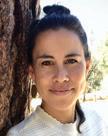
Esclamado Feola was a first-team All-SCIAC and second-team All-West Region selection as a senior in 2006, serving as a team captain and earning team MVP honors for the CMS women’s soccer team. Her efforts helped the Athenas to the SCIAC Tournament championship in the first year of the tournament’s existence, earning CMS an NCAA Division III bid. Esclamado had a standout role in the SCIAC Postseason title, converting the clinching penalty kick in a wild 15-14 shootout in the semifinals against Pomona-Pitzer in the semifinals, and then scoring the tying goal in a comeback 2-1 win over Redlands in the championship. She finished her senior season with 10 goals and five assists, giving her 25 goals and 14 assists in her career.
Nicole is a professional astrologer, parenting coach, artist and parent of two kids.

Starr is the only player in CMS Tennis and NCAA Division III history to win the Intercollegiate Tennis Association Division III National Singles title and then go on to win a match in the Small College Super Bowl (fall 2006). As a result, he held the No. 1 ranking in singles nationally as a first-year in 2006 and was an All-American. As a sophomore, Starr earned second-team All-SCIAC honors. As a junior, Starr earned ITA Scholar Athlete honors with a better than 3.5 GPA at Harvey Mudd College. Despite a career cut short because of injuries, Starr had an immense impact as a leader on the team, and he graduated with the 5th best career singles winning percentage in Stags Tennis history at .738 with his 31-11 record, and a 24-9 career record in doubles matches.
Starr has transitioned from a career in biology/pharmaceuticals to a career in computer science/IT. He is also co-founder of a literary magazine called [Alternate Route], that includes poetry, creative writing, creative nonfiction, photography and art.
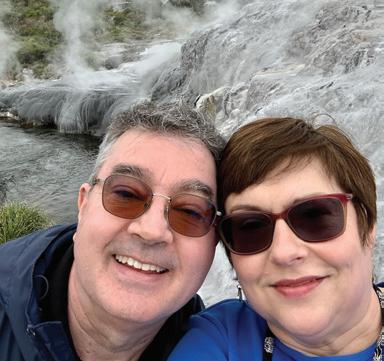
Tim Wendler (engineering) works as a client service leader (i.e., business development) for a 5,500-person engineering firm, CDM Smith. He finds that clients are very interested in renewable energy projects, including renewable natural gas, geothermal and hydrogen as well as projects that reuse water, particularly in areas with water scarcity. In his personal life, he and his wife, Joanne, enjoyed a trip to New Zealand seeing geysers, penguins, albatross and other natural beauty. Tim still serves on the Arroyos & Foothills Conservancy Board, seeking to preserve wildlife corridors in urban areas.
Brian P. Evans recently won multiple awards for his performances, including PowPAC awards for Best Choreography and Best Actor in a Major Supporting Role for his portrayal of Fritz Canigliaro in A 1940s Radio Christmas Carol, the ACT San Diego Aubrey award for Best Actor in a Major Supporting Role in a Musical for the same, and the Patio Playhouse award for Best Actor for his portrayal of Paul Becker/Nicky Vandermorgan in Footlight Frenzy
Michelle Gordon (biology) writes, “I worked in medicine for 30 years until I burned out. I founded and ran a multimillion dollar surgical practice and grew it to five surgeons. Then Covid hit, and everything went haywire. I took a bold step and left medicine altogether in July 2020. I currently host a podcast called Launch Your Life for high achievers who are ready to bounce back from burnout. Now I coach others in creating the life they’ve always wanted. My other offerings include a book of journal prompts for healthcare workers and some online courses. My son, Alex, will be 30 in April and is living a full life.”
Russell Hamilton (engineering) left financial services and started his next act as a nonprofit exec running a family foundation in San Francisco. “But, I haven’t forgotten my roots in environmental engineering, which was my first job after Mudd,” he says. “I use those skillls to evaluate startups and nonprofits trying to fight climate change.”
Vicky Colf (engineering), former CTO at Warner Bros., received the Excelsior Honor, which recognizes a leader who runs a business or finance team in the M&E industry (either manufacturer, service provider, or end-user) and who shows impressive business acumen and outstanding leadership while achieving remarkable business growth as well as a commitment to service in the community. The Hollywood Professional Association (HPA) League Honors were created to recognize diverse members of the media and entertainment community who shine as examples of accomplishment, innovation and leadership. Vicky was promoted and served as CTO/CIO at Warner Bros. Entertainment from 2017 until the close of 2020, overseeing the studio’s extensive technology services and solutions portfolio (including security). She led the development of the entertainment industry’s first-of-its-kind, completely automated, digital supply chain, Digital End-to-End (DETE), which has helped improve efficiencies and speed up time-to-market for industry-related managed content.
Jeff Allen (CS) works for Pie Aéronefs in La Sarraz, Switzerland, making an electric race airplane. He is the first and only software engineer on the team, but because it’s a startup, and because of the cross-cutting needs of aerospace engineering, he is using aspects of his Harvey Mudd education he had not used in 20 years.
Jeff King (biology) writes, “My family and I returned to California after I spent nine years working and teaching in the United Arab Emirates. I have started working for the Department of Veterans Affairs in our hometown of Ventura; we are starting a new Home Based Primary Care team that will be caring for patients in their homes. I’m excited to be part of a highly experienced and highly motivated team.”
IGM Biosciences, a clinical-stage biotechnology company focused on creating and developing engineered IgM antibodies, appointed Elizabeth H.Z. Thompson (chemistry) to its board of directors. Elizabeth is an accomplished drug development professional who has been involved in the development of important marketed medicines, most recently as the executive vice president of research and development at Horizon Therapeutics. She is also a member of the board of California Life Sciences, an influential life sciences membership organization. At Horizon, Elizabeth is responsible for overseeing all research and development activities across the company’s preclinical, clinical and marketed products. She played an important role in the acquisition and integration of Viela Bio as well as the expedited filing and approval of Tepezza, along with its successful FDA Advisory Committee meeting. She has held positions across the clinical development, business development and medical communications fields.
Ian Prowell (engineering) spent a while in dot com/IT then went back to grad school and got a PhD. “My research was in the dynamics of wind turbines. Luckily I’ve managed to stay in the field for over a decade. I’m working on expanding the capabilities of equipment intended to monitor drivetrains to track the structure’s health globally. The hope is to reduce costs, improve safety and reduce resource consumption for sustainable electricity generation.”
The U.S. Department of Energy’s (DOE) Vehicle Technologies Office hired Austin Brown (physics) as its director. Austin will lead activities for research, development, demonstration, and deployment of efficient and clean mobility options that are affordable for all Americans. He is an expert in clean energy and sustainable transportation technologies and most recently served as senior director for transportation emissions in the White House Office of Domestic Climate Policy. His previous roles included executive director of the UC Davis Policy Institute for Energy, the Environment, and the Economy; Assistant Director for Clean Energy and Transportation for the White House Office of Science and Technology Policy; and project leader for the National Renewable Energy Laboratory. Austin has also held
adjunct faculty positions at UC Davis and Johns Hopkins University and previously served as an American Association for the Advancement of Science Fellow with DOE’s Office of Energy Efficiency and Renewable Energy.
Alexander Bobbs (biology) worked in cancer research for about 15 years and earned a PhD from University of Arizona in 2012. He transitioned from research to education, teaching at Notre Dame, Lake Michigan College and Ivy Tech. He now heads the biology transfer program at Ivy Tech and lives in Kokomo, Indiana, with his wife and two kids.

Jordan Kwan (math) has been working as a patent attorney for the last 12 years. He continues to enjoy analyzing complex and challenging inventions in the algorithmic and electronic fields. Two years ago, he and his wife and dog moved from Southern California to Calgary, Alberta, Canada, where they can more easily reach the mountains (Banff National Park) and enjoy vacations more frequently. Jordan has been privileged to work at a U.S. based law firm that allows him to work from home and remotely in another country. He’s also taken this opportunity to work part time so he can raise his infant son who was born in Canada and is now the first dual citizen in the family. While his work continues to be interesting, Jordan is most captivated by his son’s exploding vocabulary at just 20 months of age.
Jeff Hellrung (math) crossed 10 years at Google, and is still in West L.A. He hasn’t gone far since those years at Mudd in the early aughts. Jeff’s recent travel has taken him snowboarding in Banff, Alberta, Canada; Big Bear, California; Colorado; and Utah. He and his wife, Sirian, welcomed their first child in April.
Max Yi (engineering) is the deputy integrated product team lead and cost account manager for Flight Operations Sustainment Team at Northrop Grumman, managing multiple sub-teams and projects that support our warfighters. He also acts in the technical capacity by providing in-depth data analysis.
Mike Bigelow (engineering) and Meredith Rawls ’08 (physics) welcomed their second child, Julian Rawls Bigelow, in November 2022. The family lives in Seattle where Mike works in systems engineering and sustainability at Seattle Children’s and Meredith works as an astronomer at the University of Washington for Vera C. Rubin Observatory.
Sheldon Logan (engineering) celebrated 10 years at Google in May 2023, and he’s finishing his second year as a member of the Alumni Association Board of Governors. He finished two out of four picture books on the wildlife of Jamaica, available on Amazon in print and ebook format.

Victor Camacho (math) got engaged and will become a stepdad to two adorable kids. He lives in San Diego and has been devoting his life to teaching and learning math and science. “I own and operate a tutoring and test prep company (High Performance Tutoring). I love using what I learned at HMC and grad school to help others excel. I still visit campus each year for the track and field alumni meet. Love reading about all the amazing things Mudders are doing. Also glad to see so many familiar faces still on the faculty, including Heather [Zinn Brooks] who I remember from grad school!”
Matt Reed (physics) has been working at HRL Laboratories in Los Angeles since getting his PhD, researching silicon heterostructure quantum dots for quantum information science. He and his wife, Olivia, celebrated the 1-year birthday of their daughter, Ava, in March.
Matthew Lawson (physics) notes: “2018: Moved to Stockholm. 2019: Co-proposed new type of dark matter detector, now being built at Oakridge. 2021: Spokesperson for ALPHA collaboration. 2022: Quit academia due to poor working conditions. 2023: Consultant currently having a blast working on wastewater treatment, and got Swedish citizenship.”

Ian Jimenez (engineering) led the development of the avionics for a rocket at ABL Space Systems with a maiden launch on Jan. 10.
Ayyappa Vemulkar (engineering) manufactures Aroma Chemicals primarily for the fragrance and flavour industry. “It’s a fun combination of organic chemistry and chemical engineering,” Ayyappa says. “The engineering curriculum at Mudd helped prep me for the various multidisciplinary challenges I face at work.”
Since graduation, Sarah Lichtman (engineering) had been working at MIT Lincoln Laboratory on defense-related projects while discovering a passion for agriculture through volunteering at local nonprofit farms. Then, her fiancé’s (Matthew Dannenberg ’16) new job in Rochester, New York, presented an opportunity for her
to change jobs as well. Last spring, Sarah took what she thought was going to be a brief sabbatical from engineering for a season of full-time farming before finding a new EE job. “It didn’t quite go as planned,” she says. “I found myself wanting to dig deeper rather than move on. I now manage a nonprofit vegetable farm. I find great personal satisfaction in the impact I have on my community through food donations and ecologically-friendly growing practices. And I find great professional satisfaction in applying my engineering skills to a whole new domain: making and adapting plans, experimenting, improving operational efficiency and hacking together the occasional greenhouse automation.”
Hayden Hatch (biology) defended his PhD in neuroscience last year and is in the final year of his MD/PhD program at the Albert Einstein College of Medicine. He is currently applying to child neurology residency programs.
2016
Double doctorates! Shanel (S) Wu (physics) and Miranda Thompson (physics) successfully defended their dissertations on April 7, 2023 at the University of Colorado Boulder. While both are physics graduates, they have taken different paths as researchers. Miranda obtained her PhD from the Department of Physics, where she conducted research at NIST on the current-phase relationship of Josephson junctions with insulating and metallic barriers. She will be continuing at NIST as a postdoc with an NRC fellowship. Shanel switched fields to pursue interdisciplinary research in creative technology design at CU’s ATLAS Institute. Shanel’s research explores the intersection of textiles, electronics and craft to design wearable technologies. Shanel will also be starting a postdoc, but in human-computer interaction at Carleton University in Ottawa, Canada.
2017
Jonathan P. Chang (CS) is a PhD candidate in computer science at Cornell, advised by Cristian Danescu-Niculescu-Mizil. Jonathan’s studies the problem of content moderation on online platforms and social media. He applies NLP and computational social science techniques both to characterize and model the patterns of misbehavior online and to develop computational tools that can help
improve the effectiveness of content moderation. He was spotlighted during Cornell University’s Impacts of A.I. Week, exploring the pitfalls of online discussions and if A.I. could step in to help.
Calvin Leung (physics) got a PhD in physics from MIT working on radio interferometry, cosmology and fast radio bursts. These are mysterious millisecondduration radio flashes originating from beyond the Milky Way. He’ll continue this research as a NASA Einstein Fellow and a Miller Research Fellow at UC Berkeley where he’ll build a new radio telescope, “with the help of awesome collaborators, including Mudd alumna Shion Andrew ’21. It will enable us to study fast radio bursts with increased precision and use them as probes of cosmology.”
Sam Hoang (engineering) completed a PhD in mechanical engineering at University of Washington in August 2022. He is am in his first year as an assistant professor at Seattle University, where he looks forward to teaching engineering to and doing research with students. He says, “I have also adopted a dog during my time in Seattle and have gotten into a variety of outdoor activities, including climbing and backpacking. I had the opportunity last summer to backpack the Enchantments after snagging a very rare permit.”

Daniel Sonner (CS) started an algorithmic trading hedge fund.
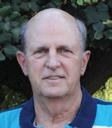
Lawrence W. Hallanger ’61 (engineering) died Nov. 6. After graduation, he continued to Caltech and completed a PhD (mechanical engineering) in 1967 while working at the Naval Civil Engineering Laboratory (NCEL). There, he volunteered for the SEALAB program and was sent to the Naval School Diving and Salvage for six months where he qualified as a Navy First Class Diver and was involved in SEALAB training before moving on to NCEL for another 10 years working in diver work systems technology development and then in the Energy Program Office. In 1978, he moved to Hawaii and managed the construction of the Seacoast Test Facility, the nucleus of what became the Natural Energy Laboratory of Hawaii. He worked at SEACO before joining Science Applications Inc. in 1984, where he remained, supporting the Navy until retiring in 2008. He enjoyed many hobbies, including scuba diving and underwater photography, restoring and driving MGs, showing Siamese cats, and taking care of his two-acre yard and traveling with his wife, Mary Ann. For the Founding Class Yearbook, Larry wrote that a fond HMC memory was “Joe Platt and his guitar in the dorm lounge in the evening” and that his lesson learned at Harvey Mudd was “How to think.”
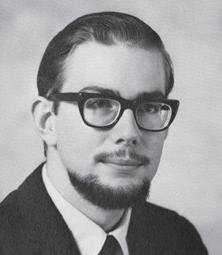
John Michael Malcolm ’68 passed away unexpectedly on Oct. 9.

Mark your calendars. On Thursday, March 14, we’re celebrating Harvey Mudd College’s Pi Day of Giving, and you’re invited! On this day, the HMC community will come together to support Mudders through gifts to the annual fund. By participating in Pi Day, you're joining others who believe in the power of a Mudd education and the limitless potential of our students. So, save the date and be a part of something exceptional!
BECOME AN ADVOCATE. Join the fun by being a social media advocate and spreading the word throughout your network to encourage participation. #MuddPiDay
MAKE AN EARLY IMPACT. Make your gift before March 14 by visiting hmc.edu/give (include “Pi Day” in the comments) or by scanning the QR code.
CHALLENGE OTHERS. Boost your impact by leveraging your gift to encourage your peers to participate in a friendly competition. Last year, 388 donors contributed!
Help make Pi Day 2024 a success. Your gift today will help launch futures and count toward Pi Day totals. For more information on how you can get involved, please contact the Office of Annual Giving at annualgiving@hmc.edu or call 909.621.8560.
SCAN TO GIVE
Don’t want to receive the print version anymore?
Just write to communications@hmc.edu, and we’ll add you to our email-only list.

Inauguration festivities will be a time of celebration and inspiration. Join us Feb. 29 and March 1 as we inaugurate Harriet B. Nembhard as the sixth president of Harvey Mudd College and honor the exceptional contributions of the College and its community members. This event is a special opportunity to unite, delving into the possibilities that will propel the College forward in an ever-evolving world.
We eagerly anticipate your presence as we celebrate the foundation upon which the College will thrive and grow.
hmc.edu/inauguration